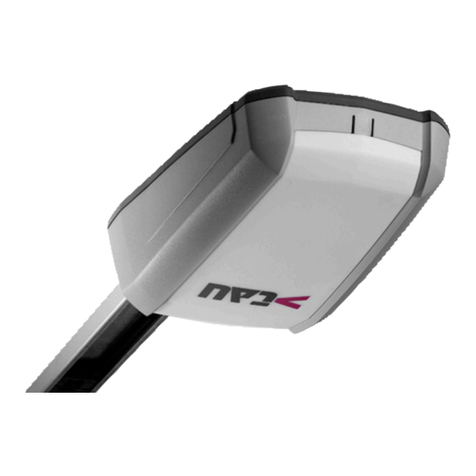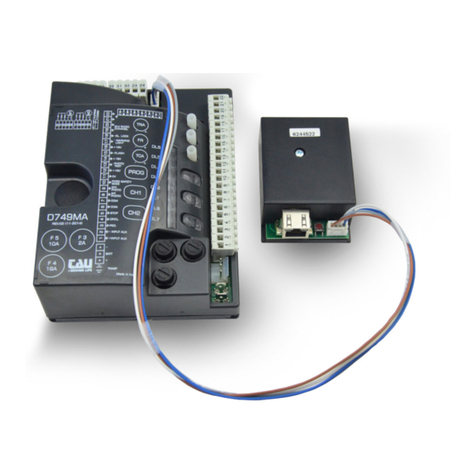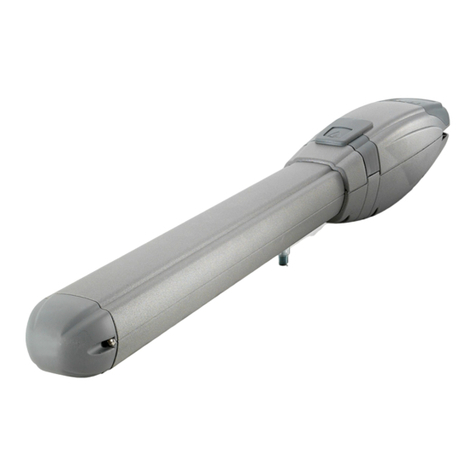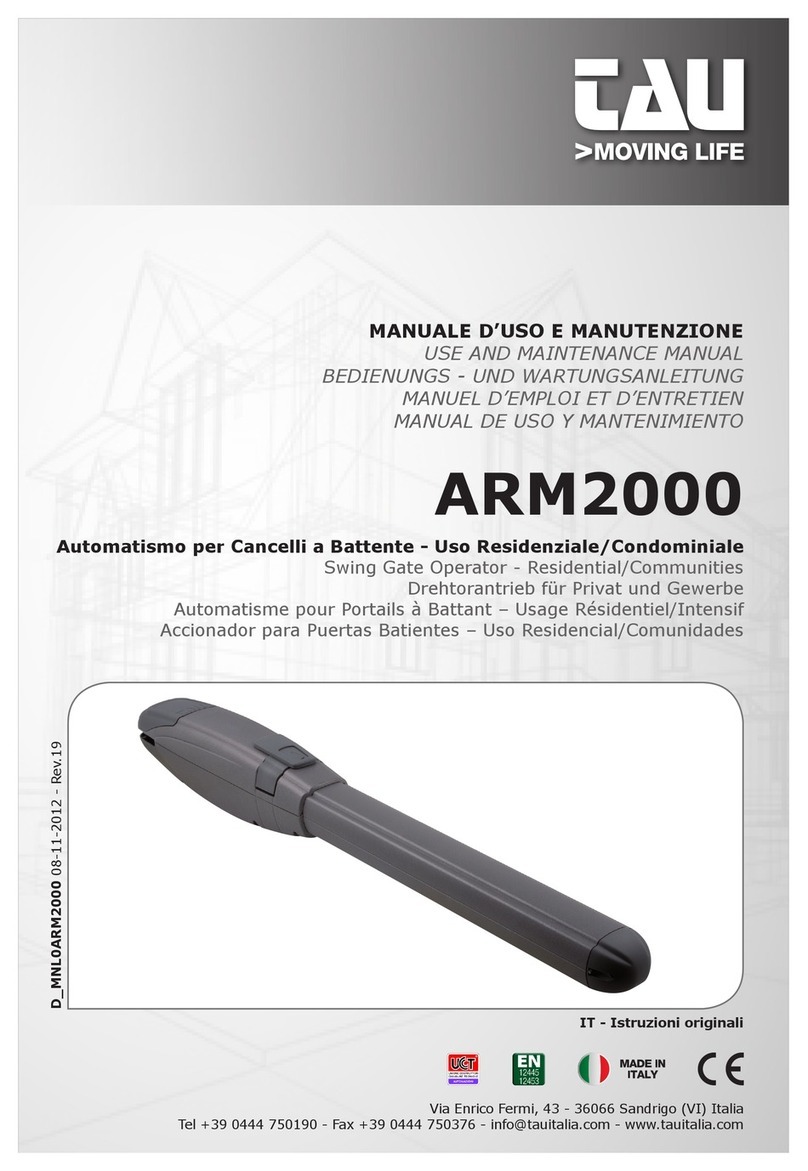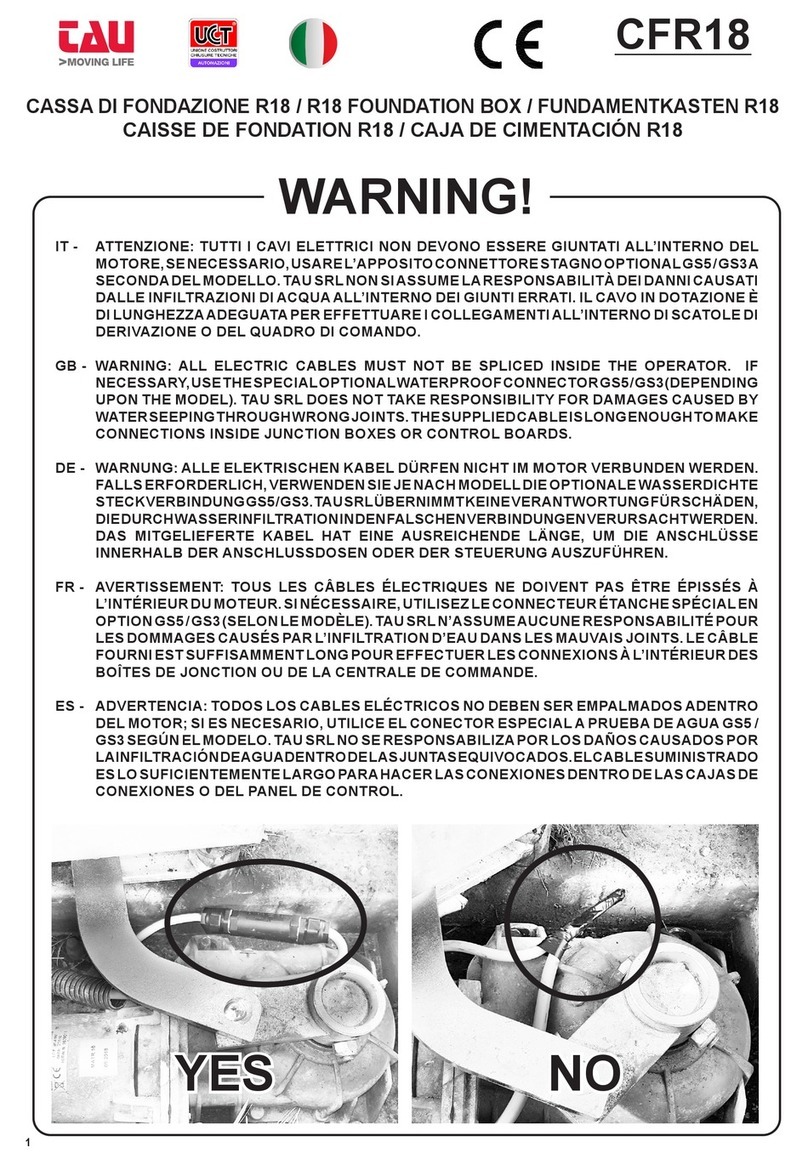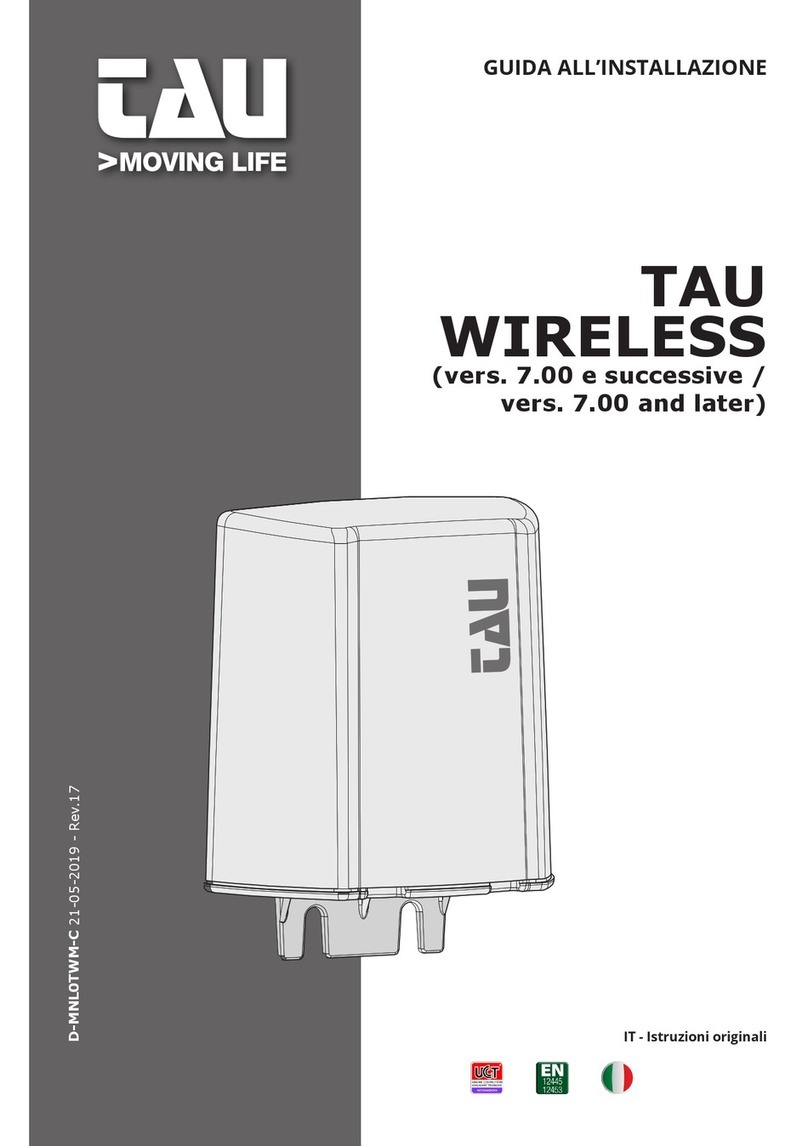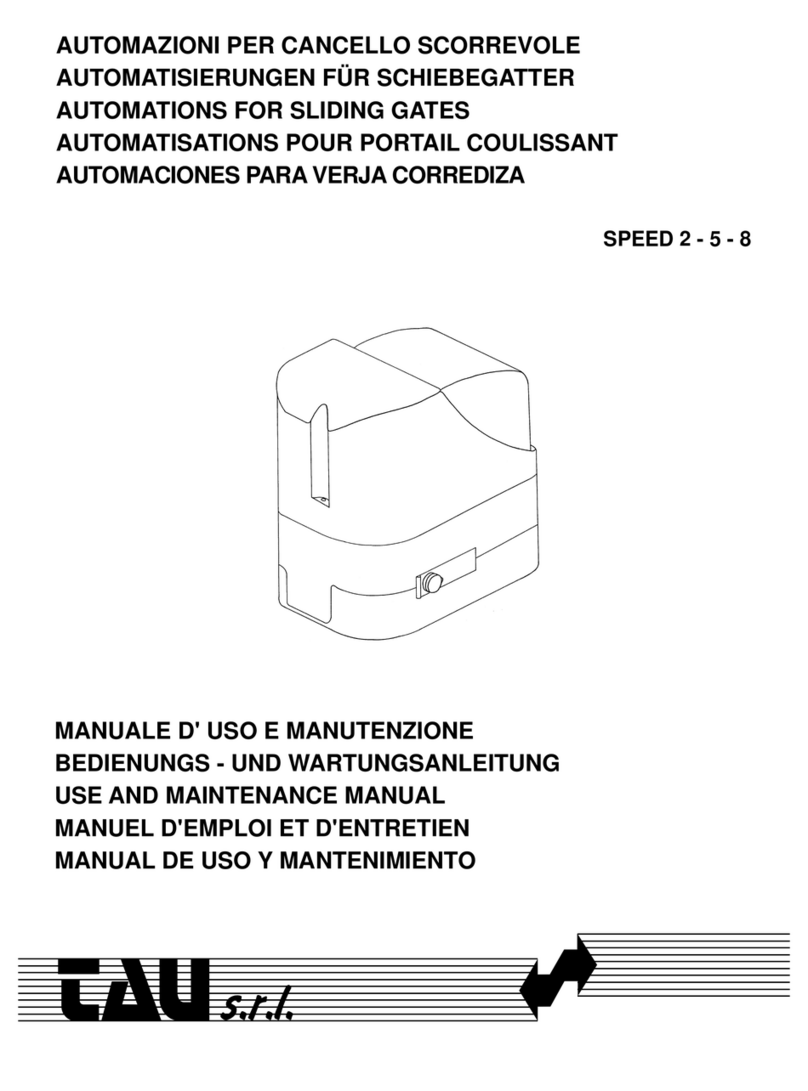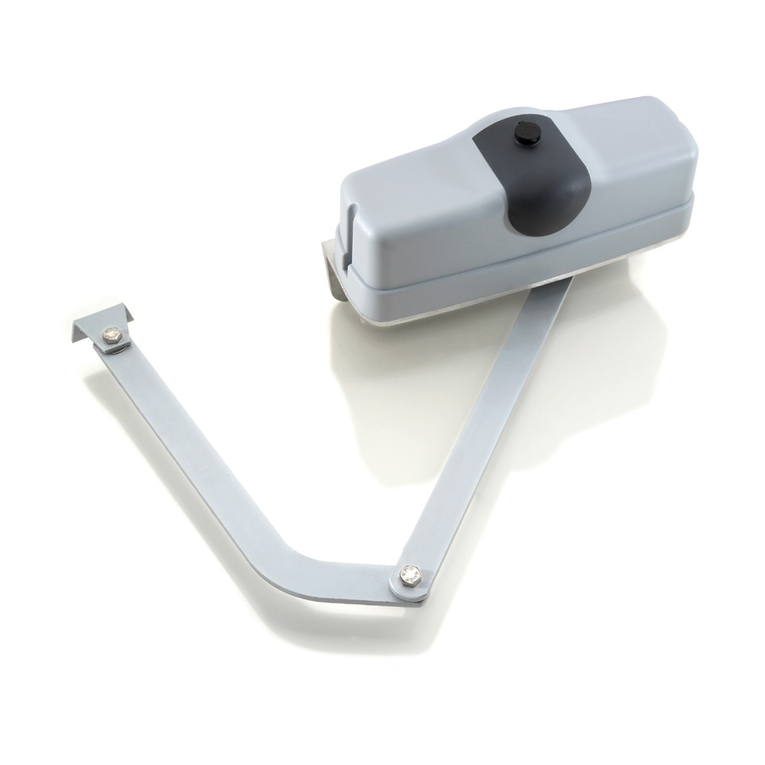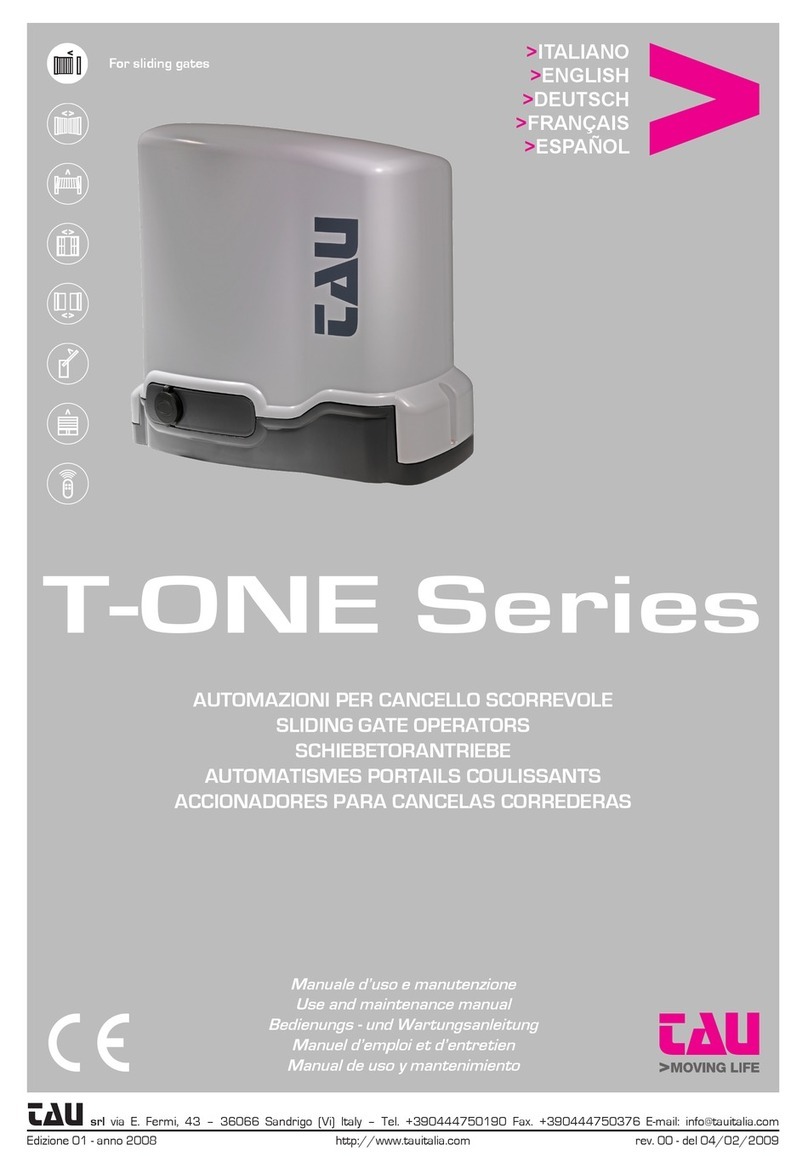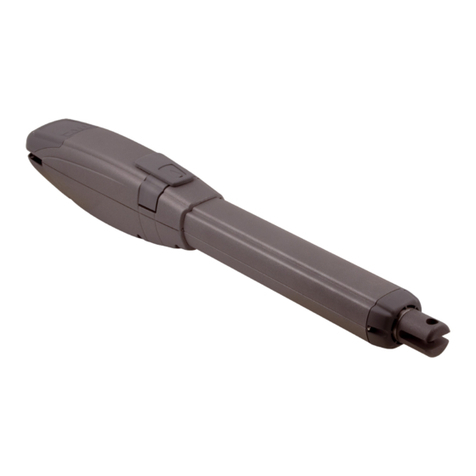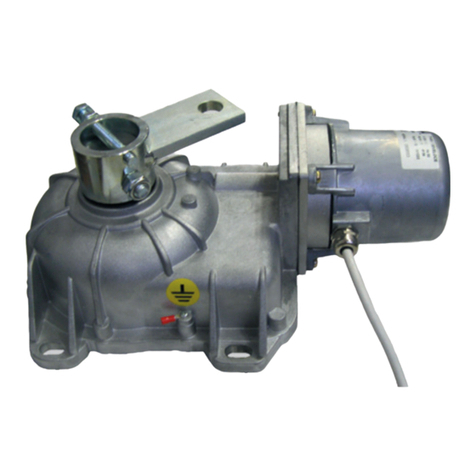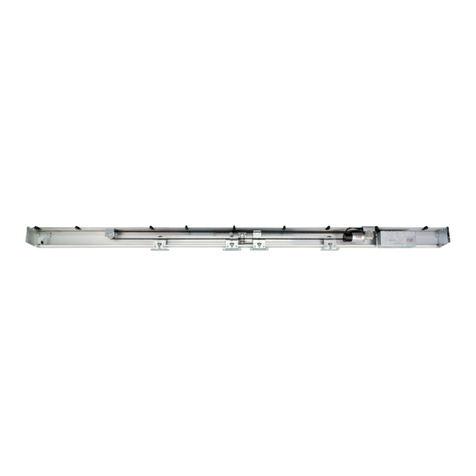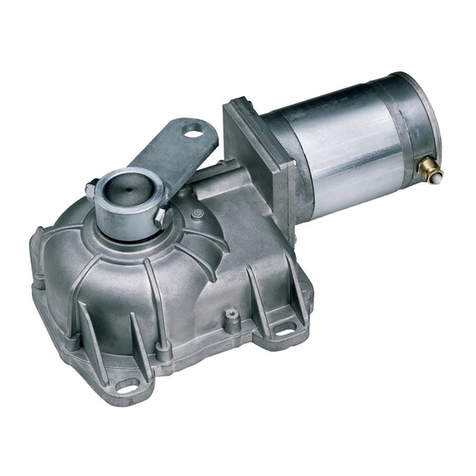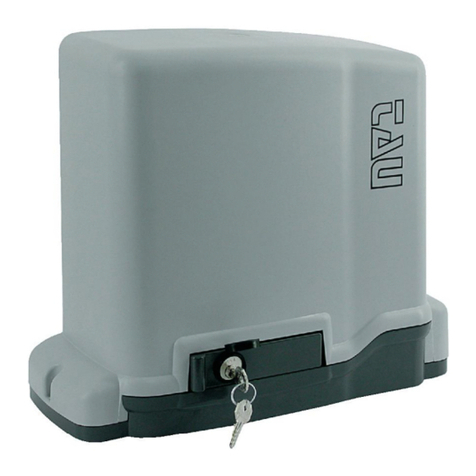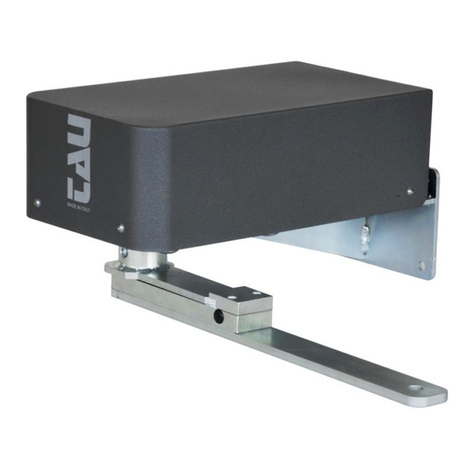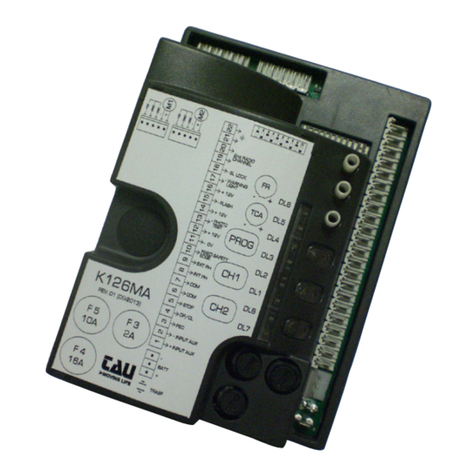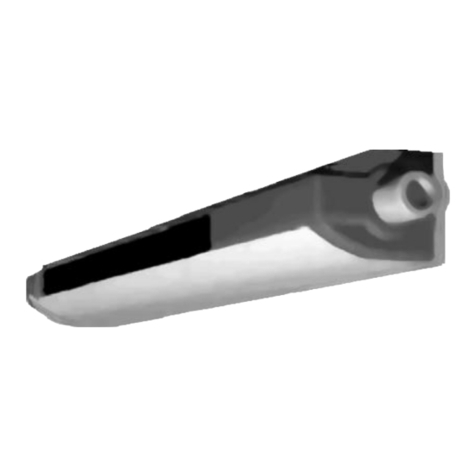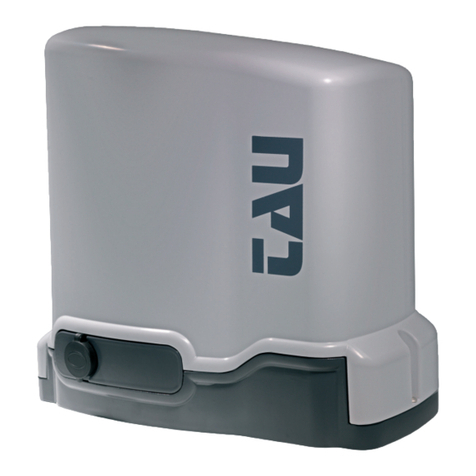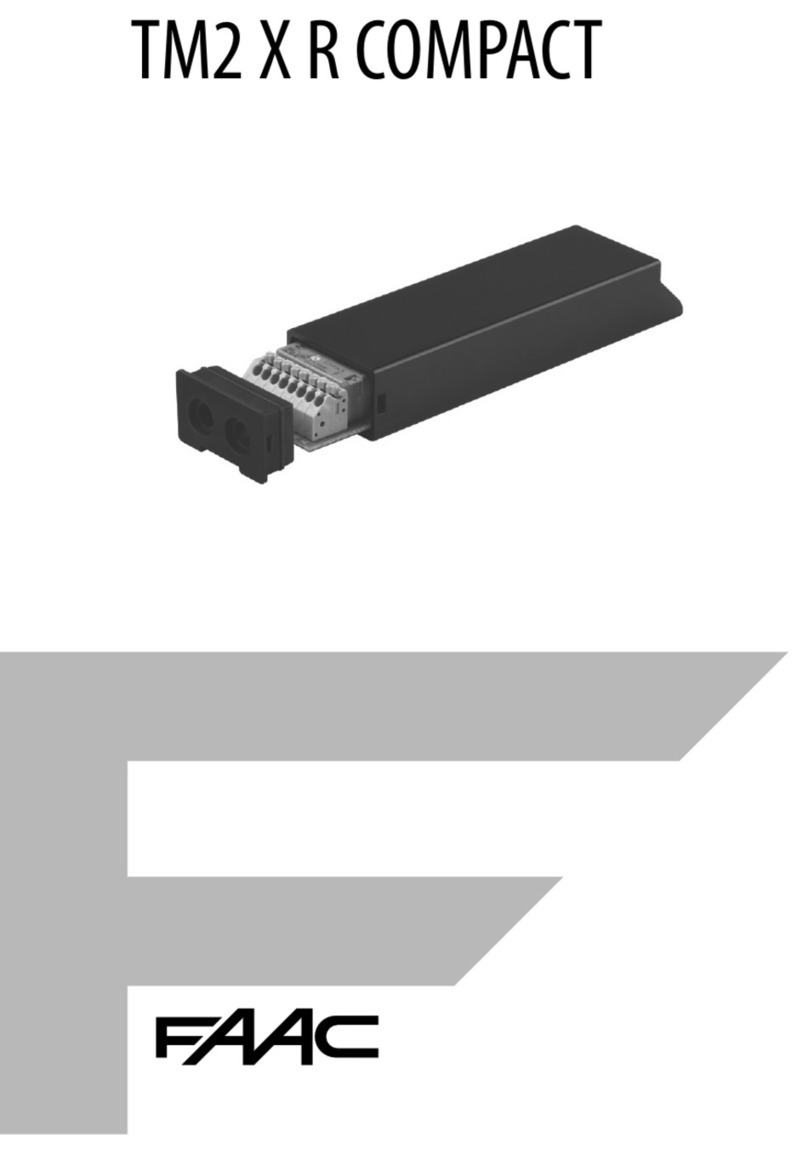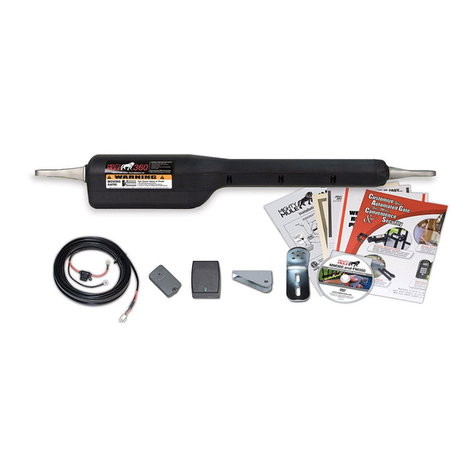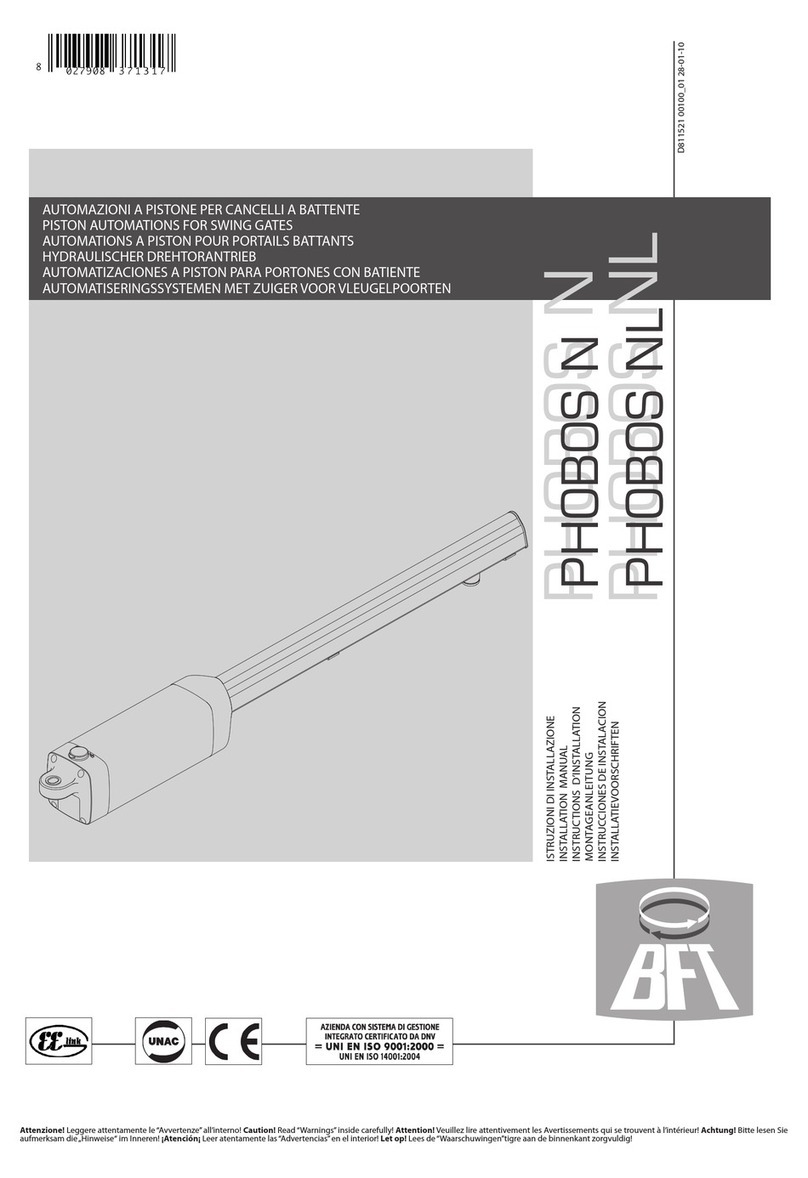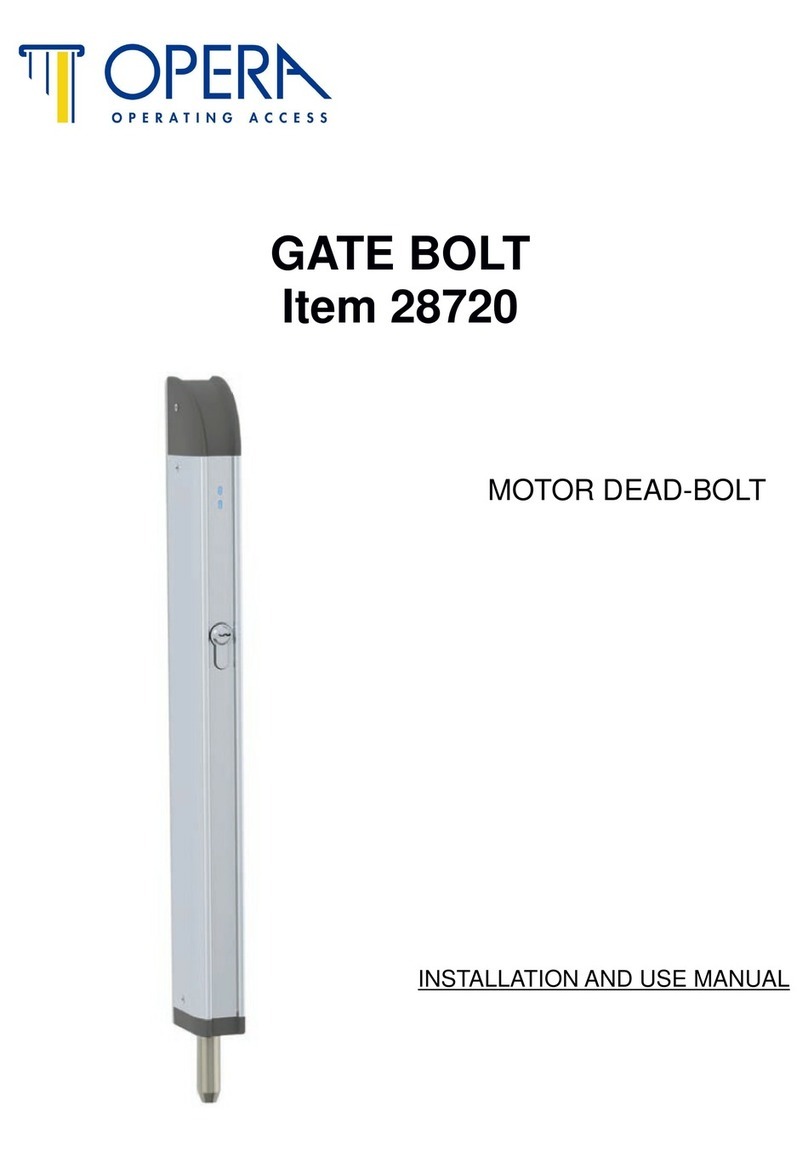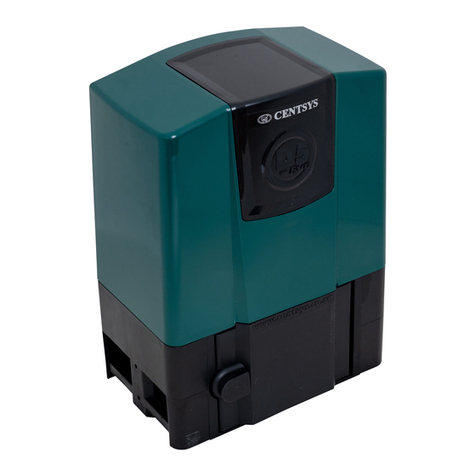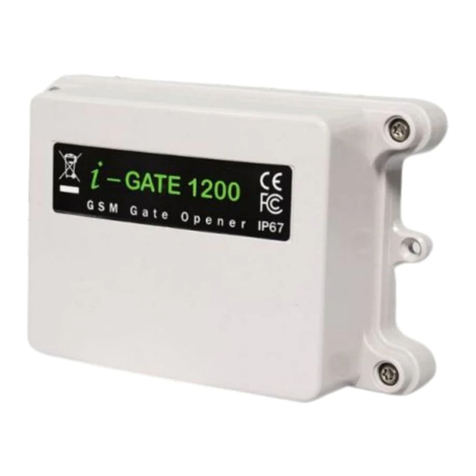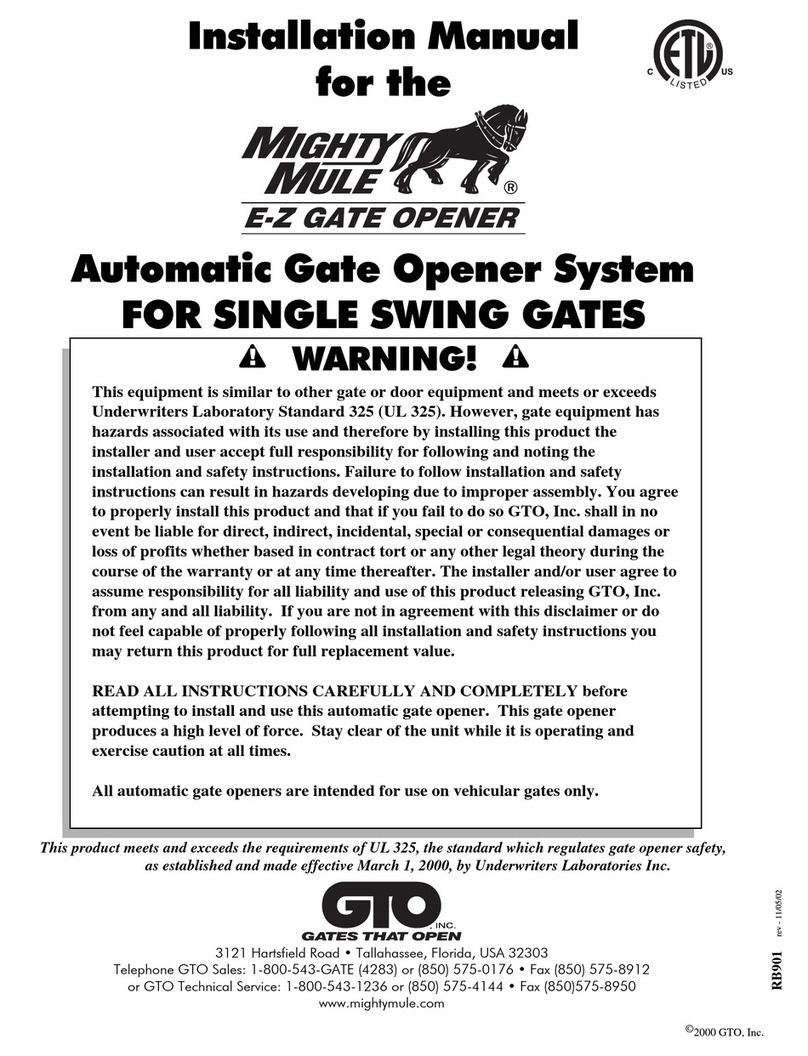tau MASTER Series User manual

1
MASTER Series
MANUALE D’USO E MANUTENZIONE
USE AND MAINTENANCE MANUAL
BEDIENUNGS - UND WARTUNGSANLEITUNG
MANUEL D’EMPLOI ET D’ENTRETIEN
MANUAL DE USO Y MANTENIMIENTO
MASTER
Motoriduttore per cancelli scorrevoli ad uso industriale
Sliding Gate Operator – Industrial
Schiebetorantrieb für Gewerbe und Industrie
Automatisme pour Portails Coulissants – Usage Industriel
Accionador para Puertas Correderas – Uso Industrial
Via Enrico Fermi, 43 - 36066 Sandrigo (VI) Italia
Tel +39 0444 750190 - Fax +39 0444 750376 - info@tauitalia.com - www.tauitalia.com
IT - Istruzioni originali
D_MNL0MASTER 16-12-2014 - Rev.27

2
MASTER Series
Italiano
Español
English
Français
Deutsch
I dati riportati nel presente manuale sono puramente indicativi. La TAU si riserva il diritto di modicarli in qualsiasi momento.
La Casa costruttrice si riserva il diritto di apportare modiche o miglioramenti al prodotto senza alcun preavviso. Eventuali imprecisioni
o errori riscontrabili nel presente fascicolo, saranno corretti nella prossima edizione.
All’apertura dell’imballo vericare che il prodotto sia integro. Riciclare i materiali secondo la normativa vigente.
L’installazione del prodotto dovrà essere effettuata da personale qualicato. La Ditta costruttrice Tau declina ogni responsabilità
per danni derivanti a cose e/o persone dovuti ad un’eventuale errata installazione dell’impianto o la non messa a Norma dello
stesso secondo le vigenti Leggi (vedi Direttiva Macchine).
Los datos describidos en este manual son puramente indicativos. La TAU se reserva el derecho de modicarlos en cualquier
momento.
El Fabricante se reserva el derecho de modicar o actualizar el producto sin aviso previo. Posibles imprecisiones o errores en este
manual serán corregidos en la próxima edición.
Cuando abra el embalaje, controle que el producto esté íntegro. Recicle los materiales según la normativa vigente.
La instalación del producto tiene que ser efectuada por personal cualicado. El Fabricante Tau no se asume ninguna
responsabilidad por lesiones a personas o averías a cosas causadas por una instalación incorrecta del equipo o la por la
inobservancia de la normativa vigente (véase Directiva de Máquinas).
The data described in this handbook are purely a guide. TAU reserves the right to change them in any moment.
The manufacturer reserves the right to modify or improve products without prior notice. Any inaccuracies or errors found in this handbook
will be corrected in the next edition.
When opening the packing please check that the product is intact. Please recycle materials in compliance with current regulations.
This product may only be installed by a qualied tter. The manufacturer declines all liability for damage to property and/or
personal injury deriving from the incorrect installation of the system or its non-compliance with current law (see Machinery
Directive).
Les données décrites dans ce manual sont purement indicatives. La TAU se réserve le droit de les modier à n’importe quel moment.
Le Constructeur se réserve le droit d’apporter des modications ou des améliorations au produit sans aucun préavis. Les éventuelles
imprécisions ou erreurs présentes dans ce fascicule seront corrigées dans la prochaine édition.
À l’ouverture de l’emballage, vérier que le produit est intact. Recycler les matériaux suivant les normes en vigueur.
L’installation du produit devra être effectuée par du personnel qualié. Tau décline toute responsabilité pour les dommages
aux choses et/ou personnes dus à une éventuelle installation erronée de l’automatisme ou à la non-mise aux normes suivant
les lois en vigueur (voir Directive Machines).
Die beschriebenen Daten in der vorliegenden Betriebsanleitung sind rein indikativ. TAU behält sich vor, diese in jedem Moment zu
modizieren.
Der Hersteller behält sich das Recht vor, ohne vorherige Benachrichtung Änderungen oder Verbesserungen am Produkt anzubringen.
Ungenauigkeiten oder Fehler, die in der vorliegenden Ausgabe festgestellt werden, werden in der nächsten Ausgabe berichtigt.
Beim Öffnen der Verpackung prüfen, dass das Produkt keine Schäden aufweist. Die Materialien nach den gültigen Vorschriften
recyclen.
Die Installation des Produktes muss von Fachpersonal ausgeführt werden. Die Herstellerrma TAU übernimmt keinerlei
Haftung für Personen- und/oder Sachschäden aufgrund einer falschen Installation der Anlage oder der Nichtkonformität
derselben mit den gültigen Gesetzen (siehe Maschinenrichtlinie).

3
MASTER Series
AVVERTENZE PER L’INSTALLATORE
OBBLIGHI GENERALI PER LA SICUREZZA
1) Leggere attentamente le istruzioni prima di procedere
all’installazione, in quanto forniscono importanti indi-
cazioni concernenti la sicurezza, l’installazione, l’uso
e la manutenzione. Una errata installazione o un errato
uso del prodotto può portare a gravi danni alle perso-
ne.
2) I materiali dell’imballaggio (plastica, polistirolo, ecc.) non
devono essere lasciati alla portata dei bambini in quanto
potenziali fonti di pericolo.
3) Conservare le istruzioni per riferimenti futuri.
4) Questo prodotto è stato progettato e costruito esclusiva-
mente per l’utilizzo indicato in questa documentazione.
Qualsiasi altro utilizzo non espressamente indicato potreb-
be pregiudicare l’integrità del prodotto e/o rappresentare
fonte di pericolo.
5) TAU declina qualsiasi responsabilità derivata dall’uso im-
proprio o diverso da quello per cui l’automatismo è destina-
to.
6) Non installare il prodotto in ambiente e atmosfera esplosivi.
7) Gli elementi costruttivi meccanici devono essere in accordo
con quanto stabilito dalle Norme EN 12604 e EN 12605.
Per i Paesi extra-CEE, oltre ai riferimenti normativi nazio-
nali, per ottenere un livello di sicurezza adeguato, devono
essere seguite le Norme sopra riportate.
8) TAU non è responsabile dell’inosservanza della Buona Tec-
nica nella costruzione delle chiusure da motorizzare, non-
ché delle deformazioni che dovessero intervenire nell’utiliz-
zo.
9) L’installazione deve essere effettuata nell’osservanza delle
Norme EN 12453 e EN 12445.
Per i Paesi extra-CEE, oltre ai riferimenti normativi nazio-
nali, per ottenere un livello di sicurezza adeguato, devono
essere seguite le Norme sopra riportate.
10) Prima di effettuare qualsiasi intervento sull’impianto, toglie-
re l’alimentazione elettrica e scollegare le batterie.
11) Prevedere sulla rete di alimentazione dell’automazione un
interruttore onnipolare con distanza d’apertura dei contatti
uguale o superiore a 3 mm. È consigliabile l’uso di un ma-
gnetotermico da 6A con interruzione onnipolare.
INSTALLATION WARNINGS
GENERAL SAFETY REQUIREMENTS
1) Carefully read all instructions before installation, as
they provide important instructions regarding the safe-
ty, installation, operation and maintenance. Incorrect
installation or use of the product may lead to serious
physical injury.
2) Never leave packaging materials (plastic, polystyrene etc.)
within the reach of children as they constitute a potential
hazard.
3) Keep the instructions in a safe place for future consultation.
4) This product has been designed and constructed exclu-
sively for the use specied in this documentation. Any other
use not specied herein may impair product integrity and/or
constitute a hazard.
5) TAU declines all liability for improper use or use other than
as specied for this automation.
6) Never install the product in explosive atmospheres.
7) The mechanical elements must comply with the require-
ments as stated in the standards EN 12604 and EN 12605.
For non European member states, in addition to the na-
tional reference standards, the above-mentioned standards
must be observed to ensure an adequate level of safety.
8) TAU is not responsible for failure to observe Good Practice
in construction of the gates/doors to be power-operated,
nor any deformations occurring during use.
9) Installation must be performed in compliance with the
standards EN 12453 and EN 12445.
For non European member states, in addition to the na-
tional reference standards, the above-mentioned standards
must be observed to ensure an adequate level of safety.
10) Before performing any operations on the system, discon-
nect from the mains and detach the batteries.
11) On the automation power line, install a device for discon-
nection from the power mains with a gap between contacts
equal to or greater than 3 mm. Use of a 6A thermal mag-
netic circuit breaker with multi-pole switch is recommended.
12) Vericare che a monte dell’impianto vi sia un interruttore
differenziale con soglia da 0,03 A.
13) Vericare che l’impianto di terra sia realizzato a regola d’ar-
te e collegarvi le parti metalliche della chiusura.
14) I dispositivi di sicurezza (norma EN 12978) permettono di
proteggere eventuali aree di pericolo da Rischi meccanici
di movimento, come ad es. schiacciamento, convoglia-
mento, cesoiamento.
15) Per ogni impianto è consigliato l’utilizzo di almeno una se-
gnalazione luminosa nonché di un cartello di segnalazione
ssato adeguatamente sulla struttura dell’insso, oltre ai
dispositivi citati al punto 14.
16) TAU declina ogni responsabilità ai ni della sicurezza e del
buon funzionamento dell’automazione in caso vengano uti-
lizzati componenti dell’impianto non di produzione TAU.
17) Per la manutenzione utilizzare esclusivamente parti origi-
nali TAU.
18) Non eseguire alcuna modica sui componenti facenti parte
del sistema d’automazione.
19) L’installatore deve fornire tutte le informazioni relative al
funzionamento manuale del sistema in caso di emergenza
e consegnare all’Utente utilizzatore dell’impianto la “Guida
Utente” allegata al prodotto.
20) Non permettere ai bambini o persone di sostare nelle vici-
nanze del prodotto durante il funzionamento.
21) Tenere fuori dalla portata dei bambini radiocomandi o qual-
siasi altro datore di impulso, per evitare che l’automazione
possa essere azionata involontariamente.
22) Il transito tra le ante deve avvenire solo a cancello comple-
tamente aperto.
23) L’utente utilizzatore deve astenersi da qualsiasi tentativo di
riparazione o d’intervento diretto e rivolgersi solo a perso-
nale qualicato.
24) Manutenzione: effettuare almeno semestralmente la ve-
rica funzionale dell’impianto, con particolare attenzione
all’efcienza dei dispositivi di sicurezza (compresa, ove
previsto, la forza di spinta dell’operatore) e di sblocco.
25) Tutto quello che non è previsto espressamente in queste
istruzioni non è permesso.
Consigliamo di riporre tutta la documentazione relativa all’im-
pianto all’interno o nelle immediate vicinanze della centralina
12) Check upline of the system that there is a residual current
circuit breaker with a threshold of 0.03 A.
13) Ensure that the earthing system is to professional stand-
ards and connected to the metal section of the gate/door.
14) The safety devices (standard EN 12978) enable the protec-
tion of danger areas from risks associated with mechani-
cal movements such as crushing, dragging and shearing.
15)
The use of at least one luminous indicator is recommended for
each system, as well as a warning notice xed suitably to the
frame structure, in addition to the devices specied in point 14.
16) TAU declines all liability for the safety and efcient opera-
tion of the automation in the event of using system compo-
nents not produced by TAU.
17) For maintenance, use exclusively original TAU parts.
18) Never modify components that are part of the automation
system.
19) The installer must provide all information regarding manual
operation of the system in the event of an emergency and
supply the system User with the “User Guide” enclosed with
the product.
20) Never allow children or other persons to stay in the vicinity
of the product during operation.
21) Keep all radio controls or other pulse supplier device out of
the reach of children to prevent inadvertent activation of the
automation.
22) Transit through the leaves is allowed only when the gate is
fully open.
23) The user must never attempt to repair or intervene directly
on the product; always contact qualied personnel for as-
sistance.
24) Maintenance: at least every six months, make a general
check of the system, with special reference to the efciency
of the safety devices (including, when envisaged, the op-
erator thrust force) and release mechanisms.
25) All actions not expressly envisaged in these instructions are
strictly prohibited.
All documentation related to the system should be kept inside
or in the immediate vicinity of the control unit.
ITALIANOENGLISH

4
MASTER Series
HINWEISE FÜR DEN INSTALLATEUR
ALLGEMEINE PFLICHTEN BEZÜGLICH DER SICHERHEIT
1) Lesen Sie vor der Installation genau die Anweisungen,
da sie wichtige Hinweise bezüglich der Sicherheit, der
Installation, der Bedienung sowie der Wartung enthal-
ten. Eine falsche Installation oder eine falsche Anwen-
dung des Produkts kann zu schweren Verletzungen
führen.
2) Das Verpackungsmaterial (Kunststoff, Polystyrol usw.) darf
nicht in der Reichweite von Kindern aufbewahrt werden, da
es eine mögliche Gefahrenquelle darstellt.
3) Die Anleitungen für einen späteren Bedarf aufbewahren.
4) Dieses Produkt wurde ausschließlich für den in diesen Un-
terlagen angegebenen Zweck entwickelt und gebaut. Jede
andere nicht ausdrücklich angegebene Nutzung könnte die
Unversehrtheit des Produkts beeinträchtigen und/oder eine
Gefahrenquelle darstellen.
5) TAU lehnt jede Verantwortung für einen unsachgemäßen
oder nicht den Angaben entsprechenden Gebrauch der Au-
tomatisierung ab.
6) Das Produkt nicht in EX-gefährdeter Atmosphäre oder Um-
gebung installieren.
7) Die mechanischen Bauteile müssen mit den Vorschriften
der Norm EN 12604 und EN 12605 übereinstimmen. In au-
ßereuropäischen Ländern müssen außer den nationalen
Vorschriften auch die oben genannten Normen befolgt wer-
den, um eine ausreichende Sicherheitsstufe zu erreichen.
8) TAU übernimmt keinerlei Haftung im Falle von nicht fachge-
rechter Konstruktion der Toröffner oder im Falle von Verfor-
mungen derselben während des Gebrauchs.
9) Die Installation muss bei Einhaltung der Normen EN 12453
und EN 12445 vorgenommen werden. In außereuropäi-
schen Ländern müssen außer den nationalen Vorschriften
auch die oben genannten Normen befolgt werden, um eine
ausreichende Sicherheitsstufe zu erreichen.
10) Vor der Ausführung beliebiger Arbeiten an der Anlage die
Stromspeisung entfernen und die Batterien abtrennen.
11)
Im Speisungsnetz der Automatisierung einen allpoligen Schal-
ter mit einer Öffnungsdistanz der Kontakte gleich oder über 3
mm vorsehen. Wir empfehlen, einen 6A-Magnetthermoschal-
ter mit einer allpoligen Unterbrechung zu verwenden.
AVERTISSEMENTS POUR L’INSTALLATEUR
CONSIGNES GÉNÉRALES DE SÉCURITÉ
1) Lire attentivement les instructions avant de procéder à
l’installation, dans la mesure où elles fournissent des
indications importantes concernant la sécurité, l’instal-
lation, l’utilisation et la maintenance. Une installation
incorrecte ou une utilisation impropre du produit peut
entraîner de graves dommages aux personnes.
2) Les matériaux de l’emballage (plastique, polystyrène ex-
pansé, etc.) ne doivent pas être laissés à la portée des en-
fants dans la mesure où ils sont une source potentielle de
danger.
3) Conserver les instructions pour toute consultation future.
4) Ce produit a été conçu et construit exclusivement pour l’uti-
lisation indiquée dans cette documentation. Toute autre uti-
lisation qui n’est pas expressément indiquée peut compro-
mettre l’intégrité du produit et/ou représenter une source de
danger.
5) TAU décline toute responsabilité dérivant de l’utilisation im-
propre ou différente de celle à laquelle l’automatisme est
destiné.
6) Ne pas installer le produit dans une atmosphère et un envi-
ronnement explosifs.
7) Les éléments mécaniques doivent être conformes aux
normes EN 12604 et EN 12605. Pour les pays extra-CEE,
en plus des normes relatives à chaque pays, pour obtenir
un niveau de sécurité adéquat, il faut respecter également
les normes susmentionnées.
8) TAU n’est pas responsable de la non-observation des
règles de l’art dans la construction des fermetures à moto-
riser, ainsi que des déformations qui pourraient se vérier
lors de l’utilisation.
9) L’installation doit être effectuée dans le respect des normes
EN 12453 et EN 12445. Pour les pays extra-CEE, en plus
des normes relatives à chaque pays, pour obtenir un ni-
veau de sécurité adéquat, il faut respecter également les
normes susmentionnées.
10) Avant d’effectuer n’importe quelle intervention sur l’instal-
lation, couper l’alimentation électrique et déconnecter les
batteries.
11)
Prévoir sur le réseau d’alimentation de l’automatisation un in-
terrupteur omnipolaire avec distance d’ouverture des contacts
égal ou supérieur à 3 mm. Il est conseillé d’utiliser un interrup-
teur magnétothermique de 6A avec interruption omnipolaire.
12) Prüfen, ob hinter der Anlage ein Differenzialschalter mit
max. 0,03 A vorliegt.
13) Prüfen, ob die Erdung fachgerecht ausgeführt wurde und
die Metallteile des Toröffners daran anschließen.
14) Die Sicherheitsvorrichtungen (Norm EN 12978) ermög-
lichen den Schutz eventueller Gefahrenbereiche vor me-
chanischen Bewegungsrisiken, wie z.B. Einquetschen,
Mitziehen, Schneiden.
15) Für jede Anlage sind die Verwendung mindestens einer
Leuchtanzeige und eines Hinweisschilds, das am Rahmen
befestigt wird, sowie die Vorrichtungen laut Punkt 14 emp-
fehlenswert.
16) TAU lehnt jede Haftung hinsichtlich der Sicherheit und der
Funktionstüchtigkeit der Automatisierung ab, falls nicht von
TAU hergestellte Anlagenteile verwendet werden.
17) Zur Instandhaltung ausschließlich TAU-Originalersatzteile
verwenden.
18) Keine Änderung an Bestandteilen des Automatisierungs-
systems ausführen.
19) Der Installateur muss alle Informationen bezüglich des ma-
nuellen Betriebs des Systems im Notfall weitergeben und
dem Anwender der Anlage die dem Produkt beigelegte „Be-
dienungsanleitung“ aushändigen.
20) Kindern oder anderen Personen nicht erlauben, während
des Betriebs in der Nähe des Produkts zu bleiben.
21) Fernsteuerungen oder andere Impulsgeber außerhalb der
Reichweite von Kindern aufbewahren, um zu vermeiden,
dass die Automatisierung ungewollt betätigt wird.
22) Der Durchgang darf nur bei stehender Automatisierung er-
folgen.
23) Der Durchgang oder die Durchfahrt zwischen den Flügeln
darf lediglich bei vollständig geöffnetem Tor erfolgen.
24) Wartung: Mindestes alle sechs Monate die Funktionstüch-
tigkeit der Anlage prüfen, mit besonderer Beachtung der
Efzienz der Sicherheitsvorrichtungen (einschließlich der
Schubkraft der Automatisierung, wo vorhanden) und der
Entriegelungsvorrichtungen.
25) Alles nicht ausdrücklich in diesen Anweisungen vorgesehe-
ne ist unzulässig.
Wir empfehlen, die ganzen Unterlagen bezüglich der Anlage
innerhalb oder in der Nähe des Steuergeräts aufzubewahren.
12) Vérier qu’en amont de l’installation il y a un interrupteur
différentiel avec seuil de 0,03 A.
13) Vérier que l’installation de mise à la terre est réalisée dans
les règles de l’art et y raccorder les parties métalliques de la
fermeture.
14) Les dispositifs de sécurité (norme EN 12978) permet-
tent de protéger les éventuelles zones de danger contre
les Risques mécaniques de mouvement, comme par
exemple l’écrasement, l’entraînement, le cisaillement.
15) Pour chaque installation il est conseillé d’utiliser au moins
une signalisation lumineuse ainsi qu’un panneau de signa-
lisation xé de manière adéquate sur le bâti de la porte ou
du portail, en plus des dispositifs cités au point 14.
16)
TAU décline toute responsabilité aux ns de la sécurité et du
bon fonctionnement de l’automatisation en cas d’utilisation de
composants de l’installation qui ne sont pas produits par TAU.
17) Pour la maintenance, utiliser exclusivement des pièces
d’origine TAU.
18) N’effectuer aucune modication sur les composants faisant
partie du système d’automatisation.
19) L’installateur doit fournir toutes les informations relatives
au fonctionnement manuel du système en cas d’urgence et
remettre à l’utilisateur de l’installation le « Guide de l’utilisa-
teur » joint au produit.
20) Ne pas permettre aux enfants ou aux personnes de station-
ner à proximité du produit durant le fonctionnement.
21) Conserver hors de portée des enfants les radiocommandes
ou tout autre dispositif émettant des impulsions, pour éviter
que l’automation puisse être actionnée involontairement.
22) Le transit entre les vantaux ne doit avoir lieu que lorsque le
portail est complètement ouvert.
23) L’utilisateur doit s’abstenir de toute tentative de réparation
ou d’intervention directe et s’adresser uniquement à du per-
sonnel qualié.
24) Maintenance : effectuer au moins une fois par semestre le
contrôle de fonctionnement de l’installation, avec une at-
tention particulière pour les dispositifs de sécurité (incluant,
quand c’est prévu, la force de poussée de l’opérateur) et de
débrayage.
25) Tout ce qui n’est pas expressément prévu dans ces instruc-
tions n’est pas autorisé.
Nous conseillons de conserver toute la documentation rela-
tive à l’installation à l’intérieur ou à proximité de la logique de
commande.
DEUTSCHFRANCAIS

5
MASTER Series
ADVERTENCIAS PARA EL INSTALADOR
OBLIGACIONES GENERALES PARA LA SEGURIDAD
1) Lea atentamente las instrucciones antes de efectuar la
instalación, ya que proporcionan indicaciones impor-
tantes acerca de la seguridad, la instalación, el uso y el
mantenimiento. Una instalación o un uso erróneo del
producto puede provocar lesiones graves a las perso-
nas.
2) Los materiales del embalaje (plástico, poliestireno, etc.) no
tienen que dejarse nunca al alcance de los niños ya que
son fuentes potenciales de peligro.
3) Conserve las instrucciones para referencias futuras.
4) Este producto se ha diseñado y construido de forma ex-
clusiva para el uso que se indica en esta documentación.
Cualquier otro uso que no se haya indicado de forma ex-
plícita podría comprometer la integridad del producto y/o
representar una fuente de peligro.
5) TAU declina cualquier responsabilidad que derive de un
uso impropio o diverso del uso para el que se ha previsto el
automatismo.
6) No instale el producto en un ambiente y/o una atmósfera
explosivos.
7) Los elementos mecánicos de la construcción tienen que
coincidir con lo que establecen las Normas EN 12604 y EN
12605. Para los países extra-CEE, además de las referen-
cias normativas nacionales, para obtener un nivel de segu-
ridad adecuado, tienen que seguirse las Normas citadas en
el punto anterior.
8) TAU no es responsable por el incumplimiento de la Buena
Técnica en la construcción de los cierres a motorizar, así
como de las deformaciones que pudieran provocarse con
el uso.
9) La instalación se tiene que efectuar cumpliendo con las
Normas EN 12453 y EN 12445. Para los países extra-CEE,
además de las referencias normativas nacionales, para ob-
tener un nivel de seguridad adecuado, tienen que seguirse
las Normas citadas en el punto anterior.
10) Antes de efectuar cualquier intervención sobre la instala-
ción, saque la alimentación eléctrica y desconecte las ba-
terías.
11) Es necesario prever sobre la red de alimentación de la
automatización un interruptor omnipolar con distancia de
apertura de los contactos igual o superior a 3 mm. Se acon-
seja la utilización de un magnetotérmico de 6A con inte-
rrupción omnipolar.
12) Compruebe que la parte inicial de la instalación disponga
de un interruptor diferencial con un umbral de 0,03 A.
13) Compruebe que la instalación de tierra esté realizada con
todas las de la ley y conecte en ella las partes metálicas del
cierre.
14) Los dispositivos de seguridad (norma EN 12978) permiten
proteger eventuales áreas de peligro de Riesgos mecá-
nicos de movimiento, como por ejemplo aplastamiento,
arrastre y cizalladura.
15) Se aconseja la utilización, en cada instalación, de por lo
menos un aviso luminoso, así como un cartel de aviso -
jado de forma adecuada en la estructura del cerramiento,
además de los dispositivos citados en el punto 14.
16) TAU declina cualquier responsabilidad respecto a la seguri-
dad y el buen funcionamiento de la automatización en caso
de que se utilicen componentes de la instalación que no
hayan sido fabricados por TAU.
17) Para el mantenimiento utilice de forma exclusiva piezas de
recambio originales TAU.
18) No efectúe ninguna modicación en los componentes que
forman parte del sistema de automatización.
19) El instalador tiene que suministrar todas las informaciones
referentes al funcionamiento manual del sistema en caso
de emergencia y entregar al usuario de la instalación la
“Guía del Usuario” que se adjunta al producto.
20) No permita a los niños u otras personas que se detengan
en los alrededores del producto durante su funcionamiento.
21) Mantenga fuera del alcance de los niños radiocontroles o
cualquier otro elemento similar para evitar que la automati-
zación pueda accionarse de forma involuntaria.
22) Sólo puede transitarse entre las hojas si la cancela está
completamente abierta.
23) El usuario tiene que evitar cualquier intento de reparación
o de intervención directa y tiene que ponerse en contacto
para ello sólo con personal especializado.
24) Mantenimiento: efectúe por lo menos cada semestre la
comprobación funcional de la instalación, prestando una
atención especial a la eciencia de los dispositivos de se-
guridad (comprendida, donde está previsto, la fuerza de
empuje del operador) y de desbloqueo.
25) Todo lo que no se ha previsto de forma explícita en estas
instrucciones no está permitido.
Aconsejamos guardar toda la documentación referente a la
instalación dentro o cerca de la centralita.
ESPAÑOL

6
MASTER Series
MASTER12Q
Motoriduttore per can-
celli no a 1200 Kg,
motore 18V, quadro
elettrico incorporato.
Gearmotor for gates
up to 1200 Kg, 18V
motor, built-in control
unit.
Getriebemotor für
Tore bis 1200 Kg, 18V
Motor, mit eingebauter
Steuerzentrale.
Motoréducteur pour
portails jusqu’à 1200
Kg, moteur 18V, cen-
trale incorporée.
Motorreductor para
verjas de hasta 1200
Kg, motor de 18V,
central incorporada.
MASTER18QR
Motoriduttore per can-
celli no a 1800 Kg,
motore 18V, quadro
elettrico incorporato.
Gearmotor for gates
up to 1800 Kg, 18V
motor, built-in control
unit.
Getriebemotor für
Tore bis 1800 Kg, 18V
Motor, mit eingebauter
Steuerzentrale.
Motoréducteur pour
portails jusqu’à 1800
Kg, moteur 18V, cen-
trale incorporée.
Motorreductor para
verjas de hasta 1800
Kg, motor de 18V,
central incorporada.
MASTER15QRF
Motoriduttore per can-
celli no a 1500 Kg,
motore 18V, quadro
elettrico incorporato.
Gearmotor for gates
up to 1500 Kg, 18V
motor, built-in control
unit.
Getriebemotor für
Tore bis 1500 Kg, 18V
Motor, mit eingebauter
Steuerzentrale.
Motoréducteur pour
portails jusqu’à 1500
Kg, moteur 18V, cen-
trale incorporée.
Motorreductor para
verjas de hasta 1500
Kg, motor de 18V,
central incorporada.
MASTER-R
Motoriduttore per can-
celli no a 1000 Kg,
motore 24V, quadro
elettrico incorporato.
Gearmotor for gates
up to 1000 Kg, 24V
motor, built-in control
unit.
Getriebemotor für
Tore bis 1000 Kg, 24V
Motor, mit eingebauter
Steuerzentrale.
Motoréducteur pour
portails jusqu’à 1000
Kg, moteur 24V, cen-
trale incorporée.
Motorreductor para
verjas de hasta 1000
Kg, motor de 24V,
central incorporada.
MASTER20QR
Motoriduttore per
cancelli no a 2000
kg, motore 230V con
quadro elettrico incor-
porato.
Gearmotor for gates
up to 2000 Kg, 230V
motor, built-in control
unit.
Getriebemotor für Tore
bis 2000 Kg, 230V
Motor, mit eingebauter
Steuerzentrale.
Motoréducteur pour
portails jusqu’à 2000
Kg, moteur 230V,
centrale incorporée.
Motorreductor para
verjas de hasta 2000
Kg, motor de 230V,
centrale incorporada.
MASTER20QM
Motoriduttore per
cancelli no a 2000
kg, motore 230V con
quadro elettrico incor-
porato e ne corsa
magnetici
Gearmotor for gates
up to 2000 Kg, 230V
motor, built-in control
unit and magnetic limit
switches.
Getriebemotor für Tore
bis 2000 Kg, 230V
Motor, mit eingebauter
Steuerzentrale und
Magnetische End-
schalter.
Motoréducteur pour
portails jusqu’à 2000
Kg, moteur 230V,
centrale incorporée et
n de course magné-
tiques.
Motorreductor para
verjas de hasta 2000
Kg, motor de 230V,
centrale incorporada
y nal de recorridos
magnéticos.
MASTER20T
Motoriduttore per
cancelli no a 2000
kg, motore 400V
trifase, senza quadro
elettrico.
Gearmotor for gates
up to 2000 Kg, 400V
three-phase motor,
without a control unit.
Getriebemotor für Tore
bis 2000 Kg, 400V
dreiphasig Motor, mit
eingebauter Steuer-
zentrale.
Motoréducteur pour
portails jusqu’à 2000
Kg, moteur 400V tri-
phasé, sans centrale.
Motorreductor para
verjas de hasta 2000
Kg, motor de 400V
trifásico, sin centrale
de mando.
DESCRIZIONE, MODELLI E CARATTERISTICHE
DESCRIPTION, MODELS AND CHARACTERISTICS
BASCHREIBUNG, MODELLE UND MERKMALE
DESCRIPTION, MODÈLES ET CARACTÉRISTIQUES
DESCRIPCIÓN, MODELOS Y CARACTERÍSTICAS
I - Imotoriduttori della serie MASTER sono stati progettati per automatizzare qualsiasi tipo di cancello scorrevole ad uso residenziale,
condominiale o industriale, con ante no a 2000 Kg. Non offre un elevato grado di sicurezza contro i tentativi di intrusione
e/o effrazione. SI FA ESPRESSO DIVETO DI UTILIZZARE L’APPARECCHIO PER SCOPI DIVERSI O IN CIRCOSTANZE
DIVERSE DA QUELLE MENZIONATE.
GB - The MASTER series of gearmotors has been designed to automate any kind of sliding gate for residential, condominium or
industrial use, with leafs weights of up to 2000 kg. It is not intended as a high degree security deterrent against intrusion
attempts and/or tampering. IT IS ALSO EXPRESSED THAT THE APPARATUS MUST NOT BE USED UNDER ANY CIR-
CUMSTANCE OR FOR ANY PURPOSE OTHER THAN THOSE STATED.
D - Die Getriebemotoren der Serie MASTER wurden für die Automatisierung von jedem Schiebetortyp mit Torügelgewicht bis 2000
kg geeignet für den Privaten so wie für den Industriellen bereich. Sie bietet keinen Hochsicherheitsgrad gegen Eindringen-
und/oder Einbruchversuchen an. ES IST AUSDRÜCKLICH VERBOTEN, DAS GERÄT ZU ANDEREN ZWECKEN ODER
UNTER ANDEREN UMSTÄNDEN ALS ERWÄHNT ZU VERWENDEN.
F - Les motoréducteurs de la série MASTER ont été projetés pour automatiser n’importe quel type de portail coulissant à
usage résidentiel, collectif ou industriel, pesant jusqu’à 2000 Kg. Il n’assure pas un niveau élevé de sécurité contre les
tentatives d’intrusion et/ou d’effraction. IL EST FORMELLEMENT INTERDIT D’UTILISER L’APPAREIL DANS DES BUTS
DIFFÉRENTS OU DANS DES CIRCONSTANCES DIFFÉRENTES DE CELLES QUI SONT MENTIONNÉES.
E - Los motorreductores de la serie MASTER han sido diseñados para automatizar cualquier tipo de cancela decorredera para uso
residencial, comunitario o industrial, con hojas de hasta 2000 Kg. No ofrece un alto grado de seguridad contra los intentos
de intrusión y/o robo. QUEDA TERMINANTEMENTE PROHIBIDO UTILIZAR EL EQUIPO PARA FINALIDADES DISTINTAS
O EN CIRCUNSTANCIAS DISTINTAS DE LAS QUE SE INDICAN.

7
MASTER Series
DATI TECNICI - TECHNICAL DATA - DONNÉES TECHNIQUES - TECHNISCHE DATEN - DATOS TÉCNICOS
MASTER12Q
MASTER18QR
MASTER15QRF
MASTER-R
MASTER20QR
MASTER20QM
MASTER20T
Frequenza - Frequency - Frequenz -
Fréquence - Frecuencia 50 - 60 Hz
Alimentazione - Power - Stromver-
sorgung - Alimentation -
Alimentación
230V AC 400V AC
Motore - Motor - Motor - Moteur -
Motor 18V DC 24V DC 230V AC 400V AC
Three-phase
Condensatore - Condenser -
Kondensator - Condensateur -
Condensador
-16 µf -
Corrente assorbita - Absorbed current -
Stromaufnahme -
Courant absorbé -
Corriente absorbida
2,6 A 2,9 A 2,8 A 3,4 A 3,7 A
Potenza assorbita - Absorbed power - Leis-
tungsaufnahme -
Puissance absorbée -
Potencia absorbida
300 W 360 W 360 W 550 W 1000 W
Spinta max. - Max. thrust -
Max. Schub - Poussée max. -
Empuje máx.
1350 N 1500 N 1400 N 1300 N 1890 N
Velocità anta - Leaf speed - Flügelges-
chwindigkeit -
Vitesse du vantail -
Velocidad hoja
11 m/min 14 m/min 18 m/min 23 m/min (opening)
14 m/min (closing) 10,5 m/min 10,5 m/min
Grado di protezione - Protection level
- Schutzart - Degré de protection -
Grado de protección
IP 44
Ciclo di lavoro - Work cycle -
Arbeitszyklus - Cycle de travail -
Ciclo de trabajo
100 % 40 % 58 %
Temperatura di esercizio - Operating
temperature -
Betriebstemperatur -
Temperature de fonctionnement -
Temperatura de trabajo
-20°C ÷ +55°C
Rapporto di riduzione - Reduction
ratio - Untersetzungsverhältnis -
Rapport de réduction -
Relación de reducción
1/30
Intervento termoprotezione - Thermal pro-
tection trips at - Eingreifen des Wärmes-
chutzes - Intervention protection thermique
-
Activatión termoprotección
-160°C 150°C
Peso max. cancello - Max. gate weight -
Torgewicht max. -
Poids max portail -
Peso máximo de la cancela
1200 Kg 1800 Kg 1500 Kg 1000 Kg 2000 Kg
Modulo pignone - Pinion module -
Ritzel modul - Module pignon -
Mòdulo piñón
4 mm
Quando il sistema in 12V DC è alimentato unicamente dalla batteria (in caso di black-out oppure in abbinamento con
pannello fotovoltaico), le prestazioni espresse dal motoriduttore (forza e velocità) si riducono del 30% ca.
When the system is in the 12V DC mode and is powered by the battery only (in the event of a power failure or when used
in conjunction with a photovoltaic panel), the gear motor’s output (power and speed) is reduced by approximately 30%.
Anmerkung: wenn das 12V DC System nur über Batterie gespeist ist (bei stromausfall oder in kombination mit einem
Photovoltaicpaneel), verringern sich die leistungen des Getriebemotors (Kraft und Geschwindigkeit) um ca. 30%.
Attention : quand le système à 12V DC est alimenté uniquement par la batterie (en cas de coupure de courant ou bien
en association avec un panneau photovoltaïque), les performances du motoréducteur (force et vitesse) diminuent
d’environ 30% .
Nota: cuando el sistema de 12V DC es alimentado únicamente por la batería (en caso de corte de corriente, o bien com-
binado con panel fotovoltaico), las prestaciones del motorreductor (fuerza y velocidad) se reducen en un 30%.

8
MASTER Series
MISURE DI INGOMBRO
Nelle gg. 1,2 e 3 sono indicate le principali misure di ingombro
per lo scorrevole; in g.8 sono riportate le dimensioni della con-
tropiastra di fondazione, mentre in g. 28 vi sono le misure della
contropiastra registrabile.
OPERAZIONI PRELIMINARI
Leggere con attenzione le poche istruzioni presenti all’interno del
manuale prima di iniziare qualsiasi operazione.
Prima di procedere all’ installazione, controllare che ci siano tutti
i componenti (g. 4), dotarsi degli strumenti idonei per lavorare e
non maneggiare su parti elettriche che siano alimentate.
MISURE PER L’INSTALLAZIONE
Per la corretta installazione del motoriduttore devono essere ri-
spettate le quote riportate nelle gg. 6 e 7 per lo scavo e la posizio-
ne, quelle di g. 11 per la posizione della contropiastra.
CONSIDERAZIONI PRELIMINARI ALL’INSTALLAZIONE
L’installazione del prodottto NON deve essere eseguita
su cancelli che aprono/chiuduno su terreno in penden-
za.
Prima di procedere all’installazione controllare che:
- le ruote del cancello siano montate in modo da rendere stabile
lo stesso, siano in buono stato ed efcienti;
- la rotaia di scorrimento sia libera, diritta e pulita su tutta la sua
lunghezza e con battute di arresto alle estremità;
- la guida superiore sia in asse con la rotaia, sia lubricata e
consenta un gioco di circa 1 mm. all’ anta;
- vericare la presenza dei battenti a pavimento.
INDIVIDUAZIONE DEL SITO
Scegliere una posizione analoga all’area tratteggiata di g. 6 nel
caso si proceda al ssaggio diretto al suolo, se questo è in calce-
struzzo, oppure come in g. 7 quando c’è da realizzare lo scavo.
PREPARAZIONE DELLA BASE
Scavare le fondazioni per almeno 15 cm. di profondità e bene al-
largate. Prevedere una guaina protettiva per i cavi.
FISSAGGIO DELLA CONTROPIASTRA DI FONDAZIONE
Nota: il posizionamento della contropiastra è corretto quando
le frecce in essa ricavate sono indirizzate una verso il cancel-
lo e l’altra verso sx (1 g. 12).
Ultimato lo scavo preparare la contropiastra di fondazione inseren-
do le zanche lettate negli appositi fori, bloccandole con i 4 dadi
bassi in dotazione nella faccia inferiore e con i 4 dadi autobloccanti
nella faccia superiore (g. 9). Nota: lasciare sporgere la parte
lettata per il ssaggio del motoriduttore per un’altezza max.
di 40 mm (g. 10). Ricoprire con calcestruzzo annegando le zan-
che; la contropiastra dovrà essere perfettamente piana ad 1 o 2
cm (g. 11) dal livello del terreno e ad una distanza di 50 mm. circa
dal cancello (g. 7).
Nota: è possibile installare il motoriduttore anche in assenza
della contropiastra di fondazione usando 4 tasselli di fonda-
zione su una base piana di calcestruzzo rispettando tuttavia
le misure indicate in g. 6.
Come optional si può utilizzare una contropiastra regolabile in al-
tezza per la quale le zanche sse devono essere saldate alla rotaia
e successivamente bloccate con 4 tasselli da fondazione M12x120
(vedi g. 29). Fissare quindi la contropiastra regolabile come indi-
cato in g. 30.
In questo modo è possibile adattare il motoriduttore ad un impianto
preesistente; vanno rispettate le misure indicate in g. 29.
ANCORAGGIO DEL MOTORIDUTTORE
Rimuovere i 4 dadi autobloccanti dalla parte lettata delle zanche,
posizionare il motoriduttore come in g. 13, quindi bloccarlo utiliz-
zando le rondelle e i già citati dadi (g. 14). Passare tutti i cavi at-
traverso i fori ricavati sulla base della contropiastra di fondazione.
Nota: sulla base in alluminio, nella sede di alloggiamento del
trasformatore, è stato ricavato un foro (g. 13) per lo scolo di
un eventuale deposito d’acqua.
Per la contropiastra regolabile le operazioni sono le medesime,
come indicato nelle gg. 31 e 32.
FISSAGGIO DELLA CREMAGLIERA
Dopo avere forato l’anta, ssare la cremagliera con viti autolettan-
ti aventi diametro di 6.3 mm, vedi g. 16.
Importante rispettare le misure di installazione e la distanza
tra dente dell’ingranaggio e dente cremagliera come indicato
nelle gg. 18, 19 e 20.
Nota: la cremagliera deve scorrere sull’ingranaggio del moto-
riduttore per l’intera larghezza del proprio dente (g. 24).
Vi sono due tipi di cremagliera disponibili: quella monoblocco stan-
dard e quella componibile in cui ogni singolo spezzone misura 50
cm. di lunghezza g. 27.
FISSAGGIO E REGOLAZIONE PATTINI DI FINECORSA
Collocare i pattini come in g. 17 e ciascuno vicino ad un estremo
della cremagliera. Movimentando l’anta manualmente, posizionare
i pattini in modo che agiscano sulla leva del microinterruttore leg-
germente prima dell’ intervento dei fermi meccanici di ne rotaia;
quindi serrare le viti.
Per un corretto funzionamento dell’automazione, la ditta co-
struttrice consiglia di mantenere la distanza tra il carter del
motoriduttore e il pattino di necorsa montato sulla crema-
gliera entro un minimo di 15 mm e un massimo di 18 mm (g.
23).
È consigliato inoltre lubricare con un po’ d’olio il punto di
contatto del pattino di necorsa con la molla, al ne di facilita-
re lo scivolamento e di evitare lo schiacciamento di quest’ul-
tima.
Nota: per una completa sicurezza si fa obbligo di installare,
se non presenti, i fermi meccanici (battenti a pavimento) con
tappo in gomma, come mostrato in g. 5.
Può vericarsi, per effetto o somma di diversi fattori
(dilatazione termica, condizioni climatiche, frequenza
di utilizzo, etc.), una variazione, nell’arco della gior-
nata, del punto di arresto del cancello, sia per la fase
di apertura che per la fase di chiusura. Non è pertanto
possibile garantire che il cancello si fermi sempre nello
stesso punto.
FINECORSA MAGNETICI (MASTER20QM)
Durante il movimento, il cancello che porta i magneti montati sulla
cremagliera si avvicina al sensore installato sul motoriduttore atti-
vandolo, comandando così l’arresto della chiusura.
I magneti devono essere installati ad una distanza dal bordo della
chiusura (X g. 17B) tenendo conto dell’inerzia del cancello. Con-
sigliamo di provare i magneti sulla cremagliera prima di ssarli in
maniera denitiva (i magneti restano ben fermi) al ne di trovare la
posizione che permetta un funzionamento ottimale.
Il magnete con polarità Nord (nero) viene utilizzato come necorsa
in apertura (FCA), quello con polarità Sud (rosso) come necorsa
in chiusura (FCC).
Nota: per una corretta attivazione del sensore magneti-
co, rispettare le quote indicate in g. 17/B.
IMPORTANTE: con i necorsa magnetici installati, è
necessario attivare la frenata (vedi istruzioni scheda di
comando, sez. dip-switches).
IMPIANTO TIPO (g. 5)
1 Motoriduttore
2Colonnina per fotocellule
3 Lampeggiante con antenna
4 Selettore a chiave
5 Fotocellule di sicurezza
6 Bordo sensibile
7 Battente a pavimento
8 Colonnina per quadro di comando
9Quadro di comando completo di contenitore
ITALIANO

9
MASTER Series
ITALIANO
Sezione cavi:
MASTER12Q
MASTER18QR MASTER20QR(M) MASTER20T
MASTER15QRF
MASTER-R
a3 x 1,5 mm² 3 x 1,5 mm² 4 x 1,5 mm²
b4 x 0,5 mm² 4 x 0,5 mm² 4 x 0,5 mm²
c2 x 0,5 mm² 2 x 0,5 mm² 2 x 0,5 mm²
d4 x 0,5 mm² 4 x 0,5 mm² 4 x 0,5 mm²
e2 x 0,5 mm² 2 x 0,5 mm² 2 x 0,5 mm²
f3 x 0,5 mm² 3 x 0,5 mm² 3 x 0,5 mm²
g2 x 0,5 mm² 2 x 0,5 mm² 2 x 0,5 mm²
hRG58 RG58 RG58
i2 x 0,5mm² 2 x 0,5mm² 2 x 0,5mm²
l(Motoriduttore) 4 x 1,5mm²
m(Finecorsa) 3 x 0,5mm²
Posizionare la centrale di comando (se esterna) nelle
immediate vicinanze dei motori.
Evitare che i cavi dei dispositivi ausiliari siano posizio-
nati all’interno di condutture dove sono presenti altri
cavi che alimentano grossi carichi o lampade con star-
ter elettronico.
Nel caso in cui vengano installati pulsanti di coman-
do o spie di segnalazione all’interno di abitazioni o di
edici che distano parecchi metri dalla centrale stessa,
è consigliabile disaccoppiare il segnale tramite relay
onde evitare disturbi indotti.
REGISTRAZIONE DELLA FRIZIONE ELETTRONICA,
ELETTRICA
ATTENZIONE: Vericare che il valore della forza d’impatto mi-
surato nei punti previsti dalla norma EN 12445 sia inferiore a
quanto indicato nella norma EN 12453.
Sul MASTER12Q la regolazione è già pre-impostata al momen-
to della programmazione della scheda e comunque tarabile (vedi
istruzioni K123M).
Per il MASTER18QR, il MASTER15QRF ed il MASTER-R la re-
golazione può essere eseguita agendo sulla scheda di comando,
vedi istruzioni K126MA.
Per il MASTER20QR ed il MASTER20QM la regolazione può
essere eseguita agendo sulla scheda di comando, vedi istruzioni
D705M.
Per il MASTER20T la regolazione può essere eseguita agendo
sulla scheda di comando, vedi istruzioni D703M.
COLLEGAMENTI ELETTRICI
Nota: la serie MASTER è provvista di un microinterruttore che
interrompe il funzionamento del motore all’atto dell’apertura
del carter, A g. 25 (la scheda rimane in tensione).
Prima di operare, assicurarsi che il motoriduttore non sia elet-
tricamente alimentato.
Per effettuare i collegamenti, togliere il carter dal motoriduttore,
passare i cavi di alimentazione attraverso i fori ricavati sulla contro-
piastra di fondazione (quando questa sia in uso) e attraverso il cor-
po inferiore del motoriduttore, quindi predisporli per il collegamento
alla morsettiera della scheda di comando alloggiata nel supporto
componenti elettrici.
La distanza massima tra la centralina e il motore non deve supe-
rare i 10 - 12 mt.
Usare cavi di sezione minima di 2.5 mm² per i circuiti di potenza
(MASTER12Q-18QR-15QRF) e di 1.5 mm² (MASTER20QR-M e
MASTER20T), di 0.5 mm²per i circuiti di comando.
Per i collegamenti alle schede comando consultare i relativi libretti
di istruzione:
- K123M MASTER12Q;
- K126MA MASTER18QR / MASTER15QRF / MASTER-R;
- D705M MASTER20QR / MASTER20QM;
- D703M MASTER20T;
Nota: la termoprotezione (solo per il MASTER20T) deve es-
sere cablata in serie al comune (morsetto 19 della scheda
D703M) dei necorsa.
INSTALLAZIONE BATTERIA 12V
Se si vuole dotare il proprio motoriduttore (MASTER12Q-18QR-
15QRF-R) di 1 batteria per garantire il funzionamento in assenza
di corrente, togliere il carter e inserirla nella apposita sede; quindi
collegare i cavi di alimentazione alle linguette.
Nota: con l’utilizzo in batteria le prestazioni per il MASTER-R
(24V DC) sono le stesse del MASTER12Q, con la stessa velo-
cità sia in apertura che in chiusura.
SBLOCCO MANUALE
In assenza di tensione di linea levare il coperchietto della serra-
tura, inlare la apposita chiave e ruotare come indicato in g. 21.
Quindi, come in g. 22, tirare la leva verso l’esterno per ottenere la
gestione manuale del cancello.
Nelle vesioni in bassa tensione viene montato un mi-
crointerruttore di sicurezza sullo sblocco (A g. 22).
Se il motore rimane sbloccato per più di 5 secondi, la
successiva manovra sarà di “RIALLINEAMENTO” (vedi
istruzioni scheda di comando, sez. “Ripristino funzio-
namento automatico”).
FINECORSA
La serie MASTER è studiata per fuzionare con dispositivo di ne
corsa elettro-meccanico a micro-switch.
I cavi sono collegati come in g. 25:
1= grigio (comune);
2= grigio (comune);
3= arancione (F.C. chiude - contatto N.C.);
4= rosso (F.C. apre - contatto N.C.);
5= grigio (comune).
Se, come rafgurato in fg. 26, quando l’ingranaggio ruota in senso
orario e la molla si sposta come indicato, la corsa non si ferma,
invertire la posizione dei li rosso ed arancione sulla morsettiera
della scheda di comando.
I cavi del sensore magnetico, per eventuali collegamenti ad altre
centrali, devono essere così cablati:
- Nero (F.C. apre - contatto N.C.);
- Marrone (F.C. chiude - contatto N.C.);
- Blu (Comune).
RACCOMANDAZIONI DI CARATTERE GENERALE
Integrare la sicurezza del cancello conformemente alla normativa
vigente.
- Scegliere percorsi brevi per i cavi e tenere separati i cavi di
potenza dai cavi di comando.
- Effettuare una corretta messa a terra dell’apparecchio.
- Per la messa a punto della coppia massima del motoriduttore,
attenersi alle normative in vigore.
- In accordo con la normativa europea in materia di sicurezza si
consiglia di inserire un interruttore esterno per poter togliere
l’alimentazione in caso di manutenzione del cancello.
- Vericare che ogni singolo dispositivo sia efciente ed efcace.
- Afggere cartelli facilmente leggibili che informino della pre-
senza del cancello motorizzato.
USO
I motoriduttori della serie MASTER sono stati progettati per mo-
vimentare cancelli a scorrimento orizzontale con ante di peso
massimo di Kg. 1000 (MASTER-R), Kg. 1200 (MASTER12Q), di
Kg. 1500 (MASTER15QRF), di Kg. 1800 (MASTER18QR), di Kg.
2000 (MASTER20QR, MASTER20QM e MASTER20T).
Si fa espresso divieto di utilizzare l’apparecchio per scopi di-
versi o in circostanze diverse da quelle menzionate.
La centralina elettronica installata consente di selezionare il fun-
zionamento:
automatico: un impulso di comando esegue l’apertura e la chiu-
sura del cancello;
semiautomatico: un impulso di comando esegue l’apertura o la
chiusura del cancello;

10
MASTER Series
In caso di mancanza di energia elettrica, il cancello può funzionare
ugualmente grazie alla possibilità di gestione manuale, per la qua-
le è necessario agire sul dispositivo di sblocco manuale. I modelli
MASTER12Q, MASTER18QR, MASTER15QRF e MASTER-R,
alimentabili con batteria tampone, garantiscono il normale funzio-
namento dell’automazione in caso di mancanza di tensione di rete.
Si ricorda che si è in presenza di un dispositivo automatico e ali-
mentato con corrente, perciò nell’utilizzo devono essere usate le
dovute precauzioni. In particolare, si ammonisce di:
• non toccare l’apparecchio con mani bagnate e/o piedi bagnati
o nudi;
• togliere la corrente prima di aprire la scatola comandi e/o il
motoriduttore;
• non tirare il cavo di alimentazione per staccare la presa di cor-
rente;
• non toccare il motore se non siete sicuri che sia raffreddato;
• mettere in movimento il cancello solo quando è completamente
visibile;
• tenersi fuori dal raggio di azione del cancello se questo è in
movimento: aspettare no a che non sia fermo;
• non lasciare che bambini o animali giochino in prossimità del
cancello;
• non lasciare che bambini o incapaci usino il telecomando o altri
dispositivi di azionamento;
• effettuare una manutenzione periodica;
• in caso di guasto, togliere l’alimentazione e gestire il cancello
manualmente solo se possibile e sicuro. Astenersi da ogni in-
tervento e chiamare un tecnico autorizzato.
NOTA: SI FA ESPRESSO DIVIETO DI LAVARE L’AUTOMAZIO-
NE UTILIZZANDO IDROPULITRICI O DISPOSITIVI SIMILARI. È
SEVERAMENTE VIETATO INDIRIZZARE GETTI D’ACQUA DI-
RETTAMENTE SULL’AUTOMAZIONE.
MANUTENZIONE
I motoriduttori della serie MASTER necessitano di poca manuten-
zione. Tuttavia il loro buon funzionamento dipende anche dallo
stato del cancello: perciò descriveremo brevemente le operazioni
da fare per avere un cancello sempre efciente.
Attenzione: nessuna persona ad eccezione del manutentore,
che deve essere un tecnico specializzato, deve poter coman-
dare il cancello automatico durante la manutenzione. Si racco-
manda perciò di togliere l’alimentazione di rete evitando così an-
che il pericolo di shock elettrici. Se invece l’alimentazione dovesse
essere presente per talune veriche, si raccomanda di controllare
o disabilitare ogni dispositivo di comando (telecomandi, pulsantie-
re etc..) ad eccezione del dispositivo usato dal manutentore.
Manutenzione ordinaria
Ciascuna delle seguenti operazioni deve essere fatta quando se
ne avverte la necessità e comunque ogni 6 mesi per un uso dome-
stico (circa 3000 cicli di lavoro) e ogni 2 mesi per un uso intensivo,
es. condominiale (sempre ogni 3000 cicli di lavoro).
Cancello
- Lubricare (con oliatore) le ruote di scorrimento del cancello;
- Vericare la pulizia e la tenuta della cremagliera;
Impianto di automazione
- verica funzionamento dispositivi di sicurezza (fotocellule, costa
pneumatica, limitatore di coppia, etc..);
Manutenzione straordinaria
Se dovessero rendersi necessari interventi non banali su par-
ti meccaniche, si raccomanda la rimozione del motoriduttore per
consentire una riparazione in ofcina dai tecnici della casa madre
o da essa autorizzati.
RUMOROSITÀ
Il rumore aereo prodotto dal motoriduttore in condizioni normali di
utilizzo è costante e non supera i 70 dB.
DEMOLIZIONE
L’eliminazione dei materiali va fatta rispettando le norme vigenti.
Nel caso di demolizione dell’automazione non esistono particolari
pericoli o rischi derivanti dall’automazione stessa.
È opportuno, in caso di recupero dei materiali, che siano separati
per tipologia (parti elettriche - rame - alluminio - plastica - etc...).
SMANTELLAMENTO
Nel caso l’automazione venga smontata per essere poi rimontata
in altro sito è necessario:
- togliere l’alimentazione e scollegare tutto l’impianto elettrico;
- rimuovere il motoriduttore dalla base di ssaggio;
- smontare tutti i componenti dell’impianto;
- nel caso alcuni componenti non possano essere rimossi o ri-
sultino danneggiati, provvedere alla loro sostituzione.
MALFUNZIONAMENTO: CAUSE E RIMEDI
Il cancello non apre, il motore non gira.
- Vericare che fotocellule o coste sensibili non siano sporche,
impegnate o non allineate. Procedere di conseguenza.
- Vericare che l’apparecchiatura elettronica sia regolarmente
alimentata, controllare l’integrità dei fusibili.
- Mediante i leds di diagnosi della centralina (vedere rispettive
istruzioni), controllare se le funzioni sono corrette. Individua-
re eventualmente la causa del difetto. Se i leds indicano che
persiste un comando di start, controllare che non vi siano ra-
diocomandi, pulsanti di start o altri didpoditivi che mantengono
attivato (chiuso) il contatto di start.
- Se la centralina non funziona, sostituirla.
Nel caso le condizioni sopra elencate diano esito negativo, sosti-
tuire il motoriduttore.
Il cancello non apre, il motore gira ma non avviene il movi-
mento.
- Lo sblocco manuale è rimasto inserito. Ripristinare il funziona-
mento motorizzato.
- Controllare se il cancello è in battuta negli arresti meccanici di
necorsa. Sbloccare manualmente il cancello, muoverlo e ripri-
stinare il funzionamento motorizzato. Controllare e correggere
la posizione dei pattini necorsa.
- Controllare che non vi siano difetti di assetto meccanico del
cancello.
Nel caso le condizioni sopra elencate diano esito negativo, sosti-
tuire il motoriduttore.
GARANZIA: CONDIZIONI GENERALI
La garanzia della TAU ha durata di 24 mesi dalla data di acquisto
dei prodotti (fa fede il documento scale di vendita, scontrino o
fattura).
La garanzia comprende la riparazione con sostituzione gratuita
(franco sede TAU: spese di imballo e di trasporto sono a carico
del cliente) delle parti che presentano difetti di lavorazione o vizi di
materiale riconosciuti dalla TAU.
In caso di intervento a domicilio, anche nel periodo coperto da ga-
ranzia, l’utente è tenuto a corrispondere il “Diritto sso di chiamata”
per spese di trasferimento a domicilio, più manodopera.
La garanzia decade nei seguenti casi:
• Qualora il guasto sia determinato da un impianto non ese-
guito secondo le istruzioni fornite dall’azienda all’interno di
ogni confezione.
• Qualora non siano stati impiegati tutti componenti originali
TAU per l’installazione dell’automatismo.
• Qualora i danni siano causati da calamità naturali, mano-
missioni, sovraccarico di tensione, alimentazione non cor-
retta, riparazioni improprie, errata installazione, o altre cau-
se non imputabili alla TAU.
• Qualora non siano state effettuate le manutenzioni periodi-
che da parte di un tecnico specializzato secondo le istruzio-
ni fornite dall’azienda all’interno di ogni confezione.
• Usura dei componenti.
La riparazione o la sostituzione dei pezzi durante il periodo di ga-
ranzia non comporta un prolungamento del termine di scadenza
della garanzia stessa.
In caso di utilizzo industriale o professionale oppure in caso di im-
piego simile, tale garanzia ha validità 12 mesi.
ITALIANO

11
MASTER Series
DICHIARAZIONE DI INCORPORAZIONE DEL COSTRUTTORE
(ai sensi della Direttiva Europea 2006/42/CE AlI. II.B)
Fabbricante: TAU S.r.l.
Indirizzo: Via E. Fermi, 43
36066 Sandrigo (Vi)
ITALIA
Dichiara sotto la propria responsabilità che il prodotto: Attuatore elettromeccanico
realizzato per il movimento automatico di: Cancelli Scorrevoli
per uso in ambiente: Condominiale / Industriale
completo di: Centrale elettronica di controllo e radioricevente
Modello: MASTER
Tipo:
MASTER12Q / MASTER18QR / MASTER15QRF /
MASTER-R / MASTER20QR / MASTER20QM / MASTER20T
Numero di serie: VEDI ETICHETTA ARGENTATA
Denominazione commerciale: AUTOMAZIONE PER CANCELLI SCORREVOLI
È realizzato per essere incorporato su una chiusura (cancello scorrevole) o per essere assemblato con altri dispositivi al ne di movi-
mentare una tale chiusura per costituire una macchine ai sensi della Direttiva Macchine 2006/42/CE.
Dichiara inoltre che questo prodotto è conforme ai requisiti essenziali di sicurezza delle seguenti ulteriori direttive CEE:
- 2006/95/CE Direttiva Bassa Tensione
- 2004/108/CE Direttiva Compatibilità Elettromagnetica
ed, ove richiesto, alla Direttiva:
- 1999/5/CE Apparecchiature Radio e apparecchiature terminali di telecomunicazione
Dichiara inoltre che non è consentito mettere in servizio il macchinario no a che la macchina in cui sarà incorporato o di cui diverrà
componente sia stata identicata e ne sia stata dichiarata la conformità alle condizioni della Direttiva 2006/42/CE.
Si impegna a trasmettere, su richiesta adeguatamente motivata delle autorità nazionali, informazioni pertinenti sulle quasi-macchine.
Sandrigo, 20/11/2014
Il Rappresentante Legale
_________________________________________
Loris Virgilio Danieli
Nome e indirizzo della persona autorizzata a costituire la documentazione tecnica pertinente:
Loris Virgilio Danieli - via E. Fermi, 43 - 36066 Sandrigo (Vi) Italia
ITALIANO

12
MASTER Series
OVERALL DIMENSIONS
The main overall dimensions of the sliding gate are indicated in g.
1, 2 and 3; the base plate dimensions are indicated in g. 8, while
the dimensions of the adjustable base plate are indicated in g. 28.
PRELIMINARY OPERATIONS
Before starting any type of operation, carefully read the instruction
present in this manual.
Before starting installation, make sure that all parts are present
(g. 4), wear suitable work clothing and accessories and do not
handle live electrical parts.
INSTALLATION MEASUREMENTS
The measurements indicated in g. 6 and 7 for the excavation and
those in g. 11 for the positioning of the base plate, must be re-
spected for the correct installation of the gearmotor.
PRE-INSTALLATION CHECKS
Use on gates with a gradient or slope is NOT allowed.
Before installation, check that:
- the wheels of the gate have been tted so that the gate itself is
stable, and that they are in good condition and
working correctly;
- the track is free, straight and clean along its entire length and
has the stops at each end;
- the upper guide is inline with the track, and is greased and al-
lows the leaf a play of approx. 1 mm;
- check that the oor stops are present.
LOCATION
If xing directly to a concrete surface, choose a position equivalent
of the area outlined in g. 6, or as in g. 7 if an excavation has to
be made.
BASE PREPARATION
Dig a sufciently wide foundation that is at least 15 cm deep. Intro-
duce a protective sheathing for the cables.
FIXING OF THE BASE PLATE
Note: the foundation counterplate is positioned correctly
when the arrows on it are pointing in the following directions:
one towards the gate and the other to the left (1 g. 12).
Once the foundations are ready, prepare the base plate by insert-
ing the threaded ties into their holes, securing them on the lower
face with the 4 narrow nuts and with the 4 locking nuts on the upper
face (g. 9). Note: the threaded section must be protruding by
no more than 40 mm in order to secure the gearmotor (g. 10).
Cover with concrete, making sure that the ties are well imbedded;
the base plate must be perfectly level and 1 or 2 cm (g. 11) from
oor level and approx. 50 mm from the gate (g. 7).
Note: The gearmotor can also be tted without the base plate,
using 4 foundation bolts on a level concrete surface making
sure that the measurements indicated in g. 6 are respected.
Optionally, a height adjustable base plate can be used. In this case
the xed ties must be welded to the track and after locked with 4
expansion bold M12x120 (see g. 29). The adjustable base plate
is then secured as indicated in g. 30.
In this way the gearmotor can be adapted to an already existing
system; the measurements indicated in g. 29 must be respected.
SECURING OF THE GEARMOTOR
Remove the 4 locking nuts from the threaded section of the ties,
position the gearmotor as illustrated in g. 13, then secure it us-
ing the washers and previously mentioned nuts (g. 14). Pass the
cables through the hole of the base plate.
Note: a hole has been arranged on the alumium base (g. 13),
under the transformer housing, to drain possible water de-
posit.
The same operations are also use for the adjustable base plate as
indicated in g. 31 and 32.
SECURING OF THE RACK
Having previously drilled the leaf, secure the rack with the 6.3 mm
diameter self-tapping screws, see g. 16.
It is extremely important that the installation measurements
and the distance between the teeth of the gear and the teeth
of the rack are respected, as indicated in g. 18, 19 and 20.
Note: the rack should run on the gearmotor gear for the entire
width of its teeth (g. 24).
There are two available types of rack: the standard enbloc type
and the sectional type of which each single piece measures 50 cm
in length g. 27.
SECURING AND ADJUSTMENT OF THE LIMIT SWITCH
PADS
Position each pad close to the end of the rack as in g. 17. Manu-
ally manoeuvring the leaf, position the pads so that they make
slight contact with the microswitch lever just before the interven-
tion of the mechanical stops at the end of the track, and tighten
the screws.
The manufacturer advises that a distance between a minimum
of 15 mm and a maximum of 18 mm should be maintained
between the gearmotor casing and the limit switch pads tted
on the rack in order for the automation system to function
correctly (g. 23).
The contact point of the limit switch pads with the spring
should also be lubricated with a little oil in order to help slid-
ing and prevent the spring from being compressed.
Note: for complete safety, the mechanical stops with rubber
cap (oor stops) must be tted, as shown in g 5.
A single factor or combination of factors (thermal ex-
pansion, climate, frequency of use, etc.) may result in
the position the gate stops in changing over the course
of the day, both when opening and when closing. Con-
sequently, we cannot guarantee that the gate will al-
ways stop in the same position.
MAGNETIC LIMIT SWITCHES (MASTER20QM)
During movement, the gate mounting the magnets tted on the
rack approaches the sensor installed on the gearmotor, and acti-
vates this sensor, consequently stopping closure.
The magnets must be installed at a distance from the closing edge
(X, g. 17B) taking gate inertia into account. We recommend test-
ing the magnets on the rack before xing them permanently (the
magnets remain rmly in place) in order to nd the correct position
for optimal operation.
The magnet with North polarity (black) is used as an opening limit
switch (OLS), and the magnet with South polarity (red) is used as
a closing limit switch (CLS).
Note: to activate correctly the magnetic sensor, dis-
tances as shown in picture 17/B must be respected
IMPORTANT: It is necessary to activate the brake func-
tion (see controller’s manual, “DIP Switches” section)
when magnetic limit switches are installed.
TYPE OF SYSTEM (g. 5)
1Gearmotor
2 Photocell column
3 Flashing light with antenna
4 key operated selector switch
5 Safety photocell
6 Sensitive edge
7 Floor stop
8 Post for control panel
9 Control panel complete with casing
ENGLISH

13
MASTER Series
ENGLISH
Cable sections:
MASTER12Q
MASTER18QR MASTER20QR(M) MASTER20T
MASTER15QRF
MASTER-R
a3 x 1,5 mm² 3 x 1,5 mm² 4 x 1,5 mm²
b4 x 0,5 mm² 4 x 0,5 mm² 4 x 0,5 mm²
c2 x 0,5 mm² 2 x 0,5 mm² 2 x 0,5 mm²
d4 x 0,5 mm² 4 x 0,5 mm² 4 x 0,5 mm²
e2 x 0,5 mm² 2 x 0,5 mm² 2 x 0,5 mm²
f3 x 0,5 mm² 3 x 0,5 mm² 3 x 0,5 mm²
g2 x 0,5 mm² 2 x 0,5 mm² 2 x 0,5 mm²
hRG58 RG58 RG58
i2 x 0,5mm² 2 x 0,5mm² 2 x 0,5mm²
l(Gearmotor) 4 x 1,5mm²
m(Limit switches) 3 x 0,5mm²
Place the control unit (external versions) in the immedi-
ate vicinity of the motors.
Be careful not to run cables for auxiliary devices in-
side raceways housing other cables supplying power
to large loads or lights with electronic starters.
In the event control pushbuttons or indicator lights are
installed inside homes or ofces several metres from
the actual control unit, it is advisable to decouple the
signal by means of a relay in order to avoid induced
interference.
ADJUSTMENT OF THE ELECTRONIC/ELECTRIC CLUTCH
WARNING: Check that the impact force value measured at the
points foreseen by the EN 12445 standard is lower than that
indicated in the EN 12453 standard.
The adjustment on MASTER12Q is already preset during the pro-
gramming of the control unit and can in any case be set (see in-
structions K123M).
The adjustment of MASTER18QR, MASTER15QRF and MAS-
TER-R can be performed through the control unit, see instructions
K126MA.
The adjustment of MASTER20QR and MASTER20QM can be
performed through the control unit, see instructions D705M.
The adjustment of MASTER20T can be performed through the
control unit, see instructions D703M.
ELECTRICAL CONNECTIONS
Note: the MASTER series has a microswitch that cuts-out the
motor when the casing is opened, A g. 25 (the control unit
remains live).
Make sure that the gearmotor is disconnected from the power
supply before performing any operations.
To make the connections, remove the gearmotor casing, pass
the cables through the holes on the base plate (when used) and
through the lower section of the gearmotor. Then arrange the ca-
bles for the connection to the control unit terminal block that is
located in the electrical components support.
The distance between the control unit and the motor must not ex-
ceed 10 – 12 m.
Use cables with a minimum section of 2.5 mm² for the power circuit
of the MASTER12Q-18QR-15QRF and 1.5 mm² for the MASTER-
20QR-M and MASTER20T, and 0.5 mm² for the control circuit.
Consult the related instructions booklet for the control unit con-
nections:
- K123M MASTER12Q;
- K126MA
MASTER18QR, MASTER15QRF and MASTER-R;
- D705M MASTER20QR and MASTER20QM.
- D703M MASTER20T;
Note: the thermal protection (for MASTER20T only) must be
wired in series to the common of the limit switch (terminal 19
of the D703M board).
12V BATTERY INSTALLATION
If one wishes to t a battery to the MASTER12Q-18QR-15QRF-R
gearmotor in order to guarantee power in the event of blackout,
remove the casing and t the battery into its location; then connect
the power supply cables to the tongues.
Note: when using in battery the performance of the MASTER-
R (24v DC) is the same as the MASTER12Q, with the same
speed both opening and closing.
MANUAL RELEASE
In the absence of the mains power supply, remove the lock cover,
insert the special key and turn it as indicated in g. 21.
Then pull the lever outwards in order to manually manage the gate,
as shown in g. 22.
DC versions feature a safety micro-switch in the re-
lease lever (“A”, pic. 22). In case the gate operator
stays released for more than 5 seconds, the operator
will perform a cycle at a slow speed to reset the op-
erating parameters to the values originally saved (see
“Restoring automatic operation”).
LIMIT SWITCH
The MASTER series has been designed to operate with a micros-
witch electromechanical limit switch device.
The cables are connected as indicated in g. 25:
1= grey (common);
2= grey (common);
3= orange (L.S. close - contact N.C.);
4= red (L.S. open - contact N.C.);
5= grey (common).
If the movement continues when the gears rotate in a clock-wise
direction and the spring moves as shown in g. 26, invert the red
and orange wires on the control unit terminal block.
In order to connect the magnetic limit switches to other control
units, wiring must be as follows:
- black (L.S. open - contact N.C.);
- brown (L.S. close - contact N.C.);
- blue (Common).
GENERAL WARNINGS
Integrate the gate safety in accordance with the present regula-
tions.
- Choose short paths for the cables and keep the power and
control cables separated;
- Make sure that the equipment is correctly grounded;
- Abide by the present regulations for the setup of the gearmo-
tor’s maximum torque;
- An external switch should be tted in compliance with the Eu-
ropean safety standards in order to turn off the power supply to
the gate for maintenance purposes;
- Make sure that all devices are efcient and in working order;
- Post clearly legible signs informing that the gate is motorised.
USE
The MASTER series gearmotors have been designed for the
movement of horizontally sliding gates weighing up to 1000 Kg for
MASTER-R, 1200 Kg for MASTER12Q, 1500 Kg for MASTER-
15QRF, 1800 Kg for MASTER18QR, and 2000 Kg for MASTER-
20QR, MASTER20QM and MASTER20T.
Use of the equipment for aims or circumstances different
from those stipulated is prohibited.
The following functions can be selected by means of the control
unit:
automatic: the gate is opened and closed following a command
input;
semiautomatic: the gate is opened or closed following a com-
mand input;
The gate can be manually controlled by means of a manual re-
lease in the event of a power failure. In the event of a power failure,
normal functioning of the MASTER12Q, MASTER18QR, MAS-
TER15QRF and MASTER-R model is guaranteed by means of a
buffer battery.

14
MASTER Series
It must be remembered that this has an automatic device and sup-
plied with power, therefore the necessary precautions must be im-
plemented while in use. Therefore it is advised:
• not to touch the equipment with wet hands and/or wet or bare
feet;
• to disconnect the power before opening the control box and/or
gearmotor;
• not to pull the power supply cable to remove the plug from the
socket;
• not to touch the motor unless you are sure that it has cooled;
• to start the manoeuvre of the gate only when it is fully visible;
• to stay outside the manoeuvring range of the gate when in
movement: wait until it has stopped moving;
• not to let children or animals play close to the gate;
• not to let children, or those unable, use the remote control or
other activating devices;
• to perform periodic maintenance;
• to disconnect the power supply and manually open and close
the gate only when possible and safe in the event of malfunc-
tion. Call an authorised technician and do not try to resolve the
problem yourself.
NOTE: THE USE OF A WATER-JET CLEANER OR SIMILAR
IS PROHIBITED FOR THE CLEANING OF THE AUTOMATION
SYSTEM. JETS OF WATER MUST NOT BE DIRECTED ONTO
THE AUTOMATION SYSTEM.
MAINTENANCE
The MASTER series gearmotors require very little maintenance.
Nevertheless, their correct functioning also depends on the state
of the gate. Therefore here is a short description of the operations
to perform in order that the gate remains in good working order.
Warning: no persons, except the specialised maintenance
technician, must activate the automatic gate during the main-
tenance operations.
Therefore the power supply should ideally be disconnected there-
by avoiding possible electric shocks. If on the other hand it is nec-
essary that the power supply is connected for the said inspection,
each control device (remote controls, push button panels, etc)
should be checked and disabled except for those being used by
the maintenance technician.
Routine maintenance
Each of the following operations must be performed when neces-
sary or in any case every 6 months for domestic use (approx. 3000
working cycles) and every 2 months for intensive use, e.g. apart-
ment blocks (again, every 3000 working cycles).
Gate
- Lubricate (with oiler) the wheels of the gate;
- Check that the rack is clean and correctly connected;
Automation system
- Check that the safety devices are working correctly (photocells,
pneumatic edges, torque limiting device, etc..);
Extraordinary maintenance
If more complicated tasks need to be performed on the mecha-
nisms, the gearmotor should ideally be removed in order for the
work to be carried out by experienced technicians in the manufac-
turers or an authorised workshop.
SOUND LEVEL
The aerial noise produced by the gearmotor under normal use is
constant and does not exceed 70 dB.
SCRAPPING
The materials must be disposed of in accordance with the current
laws and regulations.
No dangers or risks are present in the event of scrapping of the
automation system.
If materials are to be recycled, they should ideally be divided based
on their type (electrical parts – copper – aluminium – plastic –
etc…).
DISMANTLING
In the event that the automation system needs to be dismantled
and reassembled in another location, it is necessary to:
- turn off the power supply and disconnect the entire electrical
system;
- remove the gearmotor from the supporting base;
- replace all components that cannot be removed or that are
damaged.
FAULTS: TROUBLESHOOTING
The gate does not open, the motor does not turn.
- Make sure that the photocells or sensitive edges are clean,
uninhibited and aligned. Proceed accordingly.
- Make sure that the electronic equipment is correctly powered
and check that the fuses are intact.
- Check that the functions are correct by means of the control
unit LEDs (see related instructions). Identify the possible fault.
If the LEDs show that a start command is active, check that
there are no remote controls, start buttons or other devices
keeping the start contact activated (closed).
- If the control unit is not working, replace it.
If the fault is not related to one of the above mentioned conditions,
replace the gearmotor.
The gate does not open, the motor turns but no movement
occurs.
- The manual release is still on. Restore the motorised function.
- Check if the gate is in contact with the mechanical stops. Man-
ually release the gate, move it and restore the motorised func-
tion. Check and correct the position of the limit switch pads.
- Check that the gate has no mechanical adjustment defects.
If the fault is not related to one of the above mentioned conditions,
replace the gearmotor.
GUARANTEE: GENERAL CONDITIONS
TAU guarantees this product for a period of 24 months from the
date of purchase (as proved by the sales document, receipt or in-
voice).
This guarantee covers the repair or replacement at TAU’s expense
(ex-works TAU: packing and transport at the customer’s expense)
of parts that TAU recognises as being faulty as regards workman-
ship or materials.
For visits to the customer’s facilities, also during the guarantee pe-
riod, a “Call-out fee” will be charged for travelling expenses and
labour costs.
The guarantee does not cover the following cases:
• If the fault was caused by an installation that was not per-
formed according to the instructions provided by the com-
pany inside the product pack.
• If original TAU spare parts were not used to install the prod-
uct.
• If the damage was caused by an Act of God, tampering,
overvoltage, incorrect power supply, improper repairs, in-
correct installation, or other reasons that do not depend on
TAU.
• If a specialised maintenance man does not carry out routine
maintenance operations according to the instructions pro-
vided by the company inside the product pack.
• Wear of components.
The repair or replacement of pieces under guarantee does not ex-
tend the guarantee period.
In case of industrial, professional or similar use, this warranty is
valid for 12 months.
ENGLISH

1
GUIDA UTENTE - USER GUIDE - FÜHRER BENUTZER - GUIDE USAGER - GUÍA USUARIO
ISTRUZIONI ED AVVERTENZE DESTINATE ALL’UTILIZZATORE DELL’AUTOMAZIONE
COMPLIMENTI per aver scelto per la vostra automazione un prodotto Tau!
Tau S.r.l. produce componenti per l’automazione di cancelli, porte, barriere, serramenti: motoriduttori, centrali di comando, radiocomandi,
lampeggianti, fotocellule e accessori.
I prodotti Tau sono realizzati solo con materiali e lavorazioni di qualità e, come azienda, siamo alla costante ricerca di soluzioni innovative
che semplichino sempre più l’utilizzo delle nostre apparecchiature, curate sotto ogni aspetto (tecnico, estetico ed ergonomico): nella grande
gamma Tau il vostro installatore può scegliere il prodotto che meglio soddisfa le vostre esigenze.
Tau però non produce la vostra automazione che, invece, è il risultato di un’opera di analisi, di valutazione, di scelta dei materiali e realizzazione
dell’impianto eseguita dal vostro installatore di ducia.
Ogni automazione, pertanto, è unica e solo il vostro installatore può eseguire un impianto secondo le vostre esigenze (in quanto dotato
dell’esperienza e della professionalità necessarie), sicuro ed afdabile nel tempo; e soprattutto a regola d’arte, rispondente cioè alle normative
in vigore.
Un impianto di automazione è una bella comodità, oltre che un valido sistema di sicurezza e, con poche, semplici attenzioni, è destinato a
durare negli anni.
DESCRIZIONE
L’automazione MASTER per cancelli scorrevoli è un operatore elettromeccanico irreversibile che trasmette il movimento all’anta tramite un
sistema a vite senza ne. L’operatore è disponibile nelle versioni 12V DC, 230V AC e 400V AC. Il sistema irreversibile garantisce il blocco
meccanico dell’anta quando il motore non è in funzione. Un comodo e sicuro sistema di sblocco con chiave personalizzata permette la
movimentazione manuale dell’anta in caso di disservizio o di mancanza di alimentazione.
Anche se l’automazione in vostro possesso soddisfa il livello di sicurezza richiesto dalle normative, questo non esclude l’esistenza di un “rischio
residuo”, cioè la possibilità che si possano generare situazioni di pericolo, dovute ad un utilizzo incosciente e/o errato. Per questo motivo
riportiamo alcuni consigli sui comportamenti da tenere per evitare ogni inconveniente:
- Al primo utilizzo: chiedete al vostro installatore di spiegarvi l’origine dei rischi residui e leggete il presente manuale di istruzioni ed
avvertenze per l’utilizzatore consegnatovi dall’installatore. Conservate il manuale per qualsiasi problema futuro e ricordatevi di consegnarlo
ad un eventuale nuovo proprietario dell’impianto.
- L’impianto di automazione esegue fedelmente i vostri comandi: un uso incosciente e/o improprio può divenire pericoloso. Evitate
quindi di azionare l’automazione quando nel suo raggio d’azione si trovino persone, animali e/o cose.
- NON È UN GIOCO! Fate in modo che i bambini non giochino in prossimità dell’impianto e tenete i telecomandi fuori della loro portata.
- Anomalie: ad ogni comportamento anomalo dell’impianto, togliete l’alimentazione elettrica all’automazione ed eseguite lo sblocco
manuale (come da gura). Evitate qualsiasi intervento personale e chiamate il vostro installatore: una volta sbloccato, l’impianto funzionerà
manualmente come prima dell’installazione.
- Manutenzione: per durare nel tempo e funzionare in completa sicurezza, come qualsiasi altro macchinario, l’impianto necessita di una
periodica manutenzione. Stabilite insieme al vostro installatore i tempi di tale manutenzione. Tau consiglia un intervento ogni 6 mesi per un
normale uso domestico, che può variare in funzione dell’intensità d’uso (sempre ogni 3000 cicli di lavoro).
N.B. Qualsiasi tipo di intervento (controllo, manutenzione e/o riparazione) deve essere eseguito solo da personale qualicato.
- Non modicare l’impianto, nè i relativi parametri di programmazione e di regolazione: la responsabilità è dell’installatore.
N.B. Il collaudo nale, le manutenzioni periodiche e le eventuali riparazioni devono essere documentate (negli appositi spazi) da
chi le esegue e i documenti conservati dal proprietario dell’impianto (IN CASO DI MANCATA DOCUMENTAZIONE LA GARANZIA
DECADE).
- Smaltimento: al termine della vita dell’impianto assicuratevi che lo smantellamento venga eseguito da personale qualicato e che i
materiali vengano riciclati o smaltiti secondo le norme valide a livello locale.
La manovra manuale deve essere eseguita SOLO a porta ferma e DOPO aver tolto l’alimentazione alla centrale elettrica.
Nota: se il vostro impianto è dotato di un telecomando che dopo qualche tempo vi sembra funzionare peggio, oppure non funzionare affato,
potrebbe semplicemente dipendere dall’esaurimento della pila (a seconda del tipo, possono trascorrere diversi mesi no a 2/3 anni). Ve ne
potete accorgere dal fatto che la spia di conferma della trasmissione è debole, oppure si accende solo per un breve istante. Prima di rivolgervi
all’installatore provate a scambiare la pila con quella di un altro trasmettitore eventualmente funzionante: se questa fosse la causa dell’anomalia,
sarà sufciente sostituire la pila con un’altra dello stesso tipo.
Nel caso voleste aggiungere nella vostra casa un nuovo tipo di automazione, rivolgendovi allo stesso installatore e alla Tau vi garantirete,
oltre che la consulenza di uno specialista e i prodotti più evoluti del mercato, il migliore funzionamento e la massima compatibilità delle
automazioni.
Vi ringraziamo per aver letto queste raccomandazioni, e vi auguriamo la massima soddisfazione dal vostro nuovo impianto: per ogni tipo di
esigenza rivolgetevi con ducia al vostro installatore.
- - -- - - - - - - - - - - - - - - - - - - - - - - - - - - - - - - - - - - - - - - - - - - - - - - - - - - - - - - - - - - - - - - - - - - - - - - - - - - - - - - - - - - - - - - - - - - - - -
> ITALIANO
Guida
Utente
SBLOCCO MANUALE
Nel caso si renda necessario movimentare manualmente il cancello,
per mancanza di alimentazione elettrica o disservizio dell’automazione,
è necessario agire sul dispositivo di sblocco come segue:
1_ Levare il coperchietto della serratura, inserire l’appostita chiave e
ruotare come indicato in g. 1.
2_ Tirare la leva di sblocco come indicato in g. 2.
3_ Effettuare manualmente la manovra di apertura o chiusura.
RIPRISTINO DEL FUNZIONAMENTO NORMALE
Per evitare che un impulso involontario possa azionare il cancello durante
la manovra, prima di ribloccare l’operatore, togliere alimentazione
all’impianto.
1_ Richiudere la leva di sblocco.
2_ Ruotare la chiave in senso antiorario.
3_ Estrarre la chiave e chiudere il coperchietto della serratura.
4_ Muovere il cancello no all’ingranamento dello sblocco.
1 2

2
GUIDA UTENTE - USER GUIDE - FÜHRER BENUTZER - GUIDE USAGER - GUÍA USUARIO
INSTRUCTIONS AND WARNINGS FOR AUTOMATIC SYSTEM USERS
CONGRATULATIONS on choosing a Tau product for your automation system!
Tau S.r.l. produces components for automatic gates, doors, barriers and shutters. These include gear motors, control units, radio control
devices, ashing lights, photocells and accessories.
Tau products are exclusively made with top quality materials and processes and, as a company, we constantly research and develop innovative
solutions in order to make our equipment increasingly easier to use. We also pay great attention to all details (technology, appearance and
ergonomics). The extensive Tau range makes it possible for your tter to choose the product which best meets your requirements.
Tau, however, does not produce your automated system as this is the outcome of a process of analysis, evaluation, choice of materials and
installation performed by your tter.
Each automated system is unique, therefore, and only your tter has the experience and professionalism required to create a system that is
tailor-made to your requirements, featuring long-term safety and reliability, and, above all, professionally installed and compliant with current
regulations.
An automated system is handy to have as well as being a valid security system. Just a few, simple operations are required to ensure it lasts for
years.
DESCRIPTION
The MASTER automated system for sliding gates is an electro-mechanical non-reversing operator that transmits motion to the leaf via a worm
screw system.
The operator is available in 12V DC, 230V AC and 400V AC versions.
The non-reversing system ensures the leaf is mechanically locked when the motor is not operating. A convenient and safe release system with
customised key makes it possible to manually move the leaf in the event of a malfunction or of a power failure.
Even if your automated system satises regulatory safety standards, this does not eliminate “residue risks”, that is, the possibility of dangerous
situations being generated, usually due to irresponsible and/or incorrect use. For this reason we would like to give you some suggestions on
how to avoid these risks:
- Before using the system for the rst time: ask your tter to explain how residue risks can arise and read the instructions and warnings in
the user handbook that your tter will have given you. Keep this manual for future use and, if you should ever sell your automated system,
hand it over to the new owner.
- Your automated system carries out your commands to the letter: irresponsible and/or incorrect use may cause it to become dangerous.
Do not use the system if people, animals and/or objects enter its operating area.
- IT IS NOT A TOY! Make sure children do not play near the system and keep the remote control device out of their reach.
- Faults: If you notice any abnormal behaviour, disconnect the system from the power supply immediately and perform the manual release
operation (see gure). Do not attempt to repair the door but call in your tter: the system will operate manually as it did before installation.
- Maintenance: to ensure long life and totally safe operation, the system required routine maintenance, just like any other piece of machinery.
Establish maintenance times together with your tter. Tau recommends a frequency of 6 months for normal domestic installations but this
may vary depending on the intensity of use (always every 3000 work cycles).
N.B.: All controls, maintenance work and/or repairs may only be carried out by qualied personnel.
- Do not modify the plant or the relative programming and adjustment parameters: your tter will see to that.
N.B. Final testing, routine maintenance and any repairs must be documented by the tter (in the relative spaces) and such documents
kept by the owner of the system (IF THE DOCUMENTS ARE NOT PRODUCED, THE WARRANTY WILL EXPIRE).
- Disposal: At the end of system life, make sure that it is demolished by qualied personnel and that the materials are recycled or disposed
of according to local regulations.
The manual manoeuvre must ONLY be done with the door stopped and AFTER disconnecting power from the electrical control unit.
N.B.: if your remote control unit (if supplied) starts working badly after a time, or does not work at all, the batteries may be at (they can last
from several months to 2/3 years depending on what type is used). This can be seen from the fact that the transmission conrmation LED gets
dimmer or only turns on for brief moments. Before contacting your tter, try exchanging the battery with one from a good transmitter: if this is the
reason for the fault, simply replace the battery with another one of the same type.
If you wish to add a new automated system to your house, contact your tter and we at Tau to have the advice of a specialist, the most developed
products on the market, best operation and maximum automation compatibility.
Thank you for reading these suggestions and we trust you are fully satised with your new system: please contact your tter for any further
requirements.
> ENGLISH
User
Guide
MANUAL OPERATION
If the gate has to be operated manually due to a power cut or malfunction
of the automated system, use the release device as follows:
1_ Remove the cover of the lock, t the relative key and turn it as shown
in g. 1.
2_ Pull the release lever as shown in g. 2.
3_ Open and close the gate manually.
RESTORING NORMAL OPERATION
To prevent an involuntary pulse from activating the gate during the
manoeuvre, cut power to the system before relocking the operator.
1_ Re-close the release lever.
2_ Turn the key anti-clockwise.
3_ Remove the key and close the cover of the lock.
4_ Move the gate until the release meshes.
1 2

3
GUIDA UTENTE - USER GUIDE - FÜHRER BENUTZER - GUIDE USAGER - GUÍA USUARIO
ANWEISUNGEN UND HINWEISE FÜR DEN BENUTZER DER AUTOMATISIERUNG
WIR GRATULIEREN IHNEN zur Wahl eines Tau Produktes für Ihre Automatisierung!
Tau S.r.l. stellt Komponenten für die Automatisierung von Toren, Türen, Schranken und Fenstern her: Getriebemotoren, Steuerzentralen,
Funksteuerungen, Blinkleuchten, Fotozellen und Zubehör.
Die Tau Produkte werden nur mit Materialien und Bearbeitungen hoher Qualität hergestellt, und unsere Firma ist auf der ständigen Suche nach
innovativen Lösungen, mit denen die Benutzung unserer Apparaturen, die in jeder Hinsicht (Technik, Aussehen und Ergonomie) besonders
gepegt sind, immer einfacher wird: unter dem großen Tau Sortiment kann Ihr Installateur das Produkt auswählen, das Ihrem Bedarf am besten
entspricht.
Tau ist aber nicht der Hersteller Ihrer Automatisierung, die dagegen das Ergebnis des Werks Ihres Vertrauensinstallateurs ist, der sich mit den
notwendigen Untersuchungen und Bewertungen, der Wahl der Materialien und der Verwirklichung die Anlage beschäftigen wird.
Jede Automatisierung ist daher einzigartig und nur Ihr Installateur kann eine Anlage ausführen, die Ihrem Bedarf entspricht (er besitzt die
notwendige Erfahrung und Professionalität), die sicher und auf Zeit zuverlässig und vor allem fachgerecht ist und mit den gültigen Vorschriften
übereinstimmt.
Eine Automatisierungsanlage ist etwas wirklich bequemes, aber auch ein gutes Sicherheitssystem, und mit ein paar einfachen Maßnahmen
wird sie jahrelang dauern.
BESCHREIBUNG
Die Automation MASTER für Schiebetore ist ein irreversibler elektromechanischer Antrieb, der über ein Schneckensystem die Bewegung auf
den Flügel überträgt.
Der antrieb ist Verfügbar in 12V DC, 230V AC und 400V AC.
Das irreversible System gewährleistet die mechanische Verriegelung des Flügels, wenn der Motor nicht in Betrieb ist. Ein praktisches und sicheres
Freigabesystem mit individuellem Schlüssel ermöglicht die manuelle Bewegung des Flügels bei Betriebsstörungen oder Stromausfall.
Auch wenn Ihre Automatisierung dem Sicherheitsniveau entspricht, das von den Vorschriften gefordert wird, schließt dies das Vorhandensein
eines „Restrisikos” nicht aus, bzw. der Möglichkeit, dass Gefahren aufgrund eines fahrlässigen und/oder falschen Gebrauchs erzeugt werden
können. Aus diesem Grund geben wir hier einige Verhaltensweisen an, um diese möglichen Restrisiken zu vermeiden:
- Bei der ersten Benutzung: bitten Sie Ihren Installateur, Ihnen den Ursprung der Restrisiken zu erklären, und lesen Sie die vorliegenden
Anweisungen und Hinweise für den Benutzer, die Ihnen vom Installateur übergeben werden. Bewahren Sie die Anleitung für zukünftige
Probleme auf, und übergeben Sie diese ggf. dem neuen Besitzer der Anlage.
- Die Automatisierungsanlage folgt getreu Ihren Befehlen: ein fahrlässiger und/oder unsachgemäßer Gebrauch kann gefährlich sein.
Betätigen Sie daher die Automatisierung nicht, wenn sich Personen, Tiere und/oder Gegenstände in ihrem Aktionskreis benden.
- SIE IST KEIN SPIEL! Lassen Sie Kinder nicht in der Nähe der Anlage spielen und halten Sie die Fernbedienungen außer deren
Reichweite.
- Störungen: schalten Sie bei jedem ungewöhnlichen Verhalten der Anlage die Stromversorgung zur Automatisierung ab und entriegeln
Sie von Hand (siehe Abbildung). Vermeiden Sie jeden persönlichen Eingriff und rufen Sie Ihren Installateur: nach dem Entriegeln wird die
Anlage von Hand funktionieren, wie vor der Installation.
- Wartung: um zu dauern und ganz sicher zu funktionieren, bedarf die Anlage wie jede andere Maschine einer periodischen Wartung. Legen
Sie die Wartungszeiten zusammen mit Ihrem Installateur fest. Tau empehlt für den normalen Hausgebrauch eine Wartung alle 6 Monate,
was je nach Gebrauchshäugkeit unterschiedlich sein kann (immer ungefähr 3000 Arbeitszyklen).
N.B.: Eingriffe (Kontrolle, Wartung und/oder Reparatur) dürfen nur von Fachpersonal ausgeführt werden.
- Anlage und programmierte und eingestellte Parameter nicht ändern, das ist Aufgabe des Installateurs.
N.B.: Endprüfung, periodische Wartungsarbeiten und eventuelle Reparaturen müssen von dem, der sie ausführt, belegt sein (in
den dazu bestimmten Feldern); diese Unterlagen muss der Besitzer der Anlage aufbewahren (DIE GARANTIE WIRD UNGÜLTIG,
FALLS DIE DOKUMENTATION FEHLT).
- Entsorgung: stellen Sie am Ende der Lebensdauer der Anlage sicher, dass die Entsorgung durch Fachpersonal erfolgt und dass die
Materialien nach den örtlich gültigen Vorschriften recycled oder entsorgt werden.
Die manuelle Bewegung darf AUSSCHLIESSLICH bei stehendem Tor und NACH Abschalten der Versorgung zur Steuerung ausgeführt
werden.
Anmerkung: wenn eine Fernbedienung zu Ihrer Anlage gehört, die nach einer bestimmten Zeit schlechter oder gar nicht funktioniert, sollten Sie
die Batterie kontrollieren, die ganz einfach leer sein könnte (je nach Typ, kann die Batterie mehrere Monate bis 2-3 Jahre dauern). Sie können
das am Leuchtmelder bemerken, der die Übertragung bestätigt und nur schwach oder ganz kurz aueuchten wird. Tauschen Sie die Batterie
mit der eines anderen, funktionierenden Senders aus, bevor Sie sich an den Installateur wenden: falls die Ursache der Betriebsstörung eine
leere Batterie sein sollte, genügt es, diese mit einer anderen gleichen Typs zu ersetzen.
Falls Sie Ihrem Haus eine weitere neue Automatisierung hinzufügen wollen, werden Sie sich bei Ihrem Installateur und bei Tau neben der
Beratung eines Fachmanns die fortgeschrittensten Produkte garantieren, die es auf dem Markt gibt, mit bestem Betrieb und maximaler
Kompatibiltät der Automatisierungen.
Wir danken Ihnen, dass Sie diese Hinweise gelesen haben und wünschen Ihnen volle Zufriedenheit mit Ihrer neuen Anlage. Wenden Sie sich
für jeden Bedarf vertrauensvoll an Ihren Installateur.
> DEUTSCH
Führer
Benutzer
MANUELLER BETRIEB
Sollte eine manuelle Bewegung des Tors aufgrund eines Ausfalls der
Stromversorgung oder einer Betriebsstörung der Automation erforderlich
werden, so ist die Entriegelungsvorrichtung wie folgt zu bedienen:
1_ Deckel des Schlosses heben, den Schlüssel einstecken und wie in
Abb. 1 gezeigt drehen.
2_ Den Entriegelungshebel ziehen, wie in Abb. 2 gezeigt.
3_ Manuell die Bewegungen der Öffnung oder der Schließung
ausführen.
WIEDERHERSTELLUNG DES NORMALEN BETRIEBS
Um zu vermeiden, daß das Tor während des Manövers versehentlich
betrieben wird, ist vor der erneuten Verriegelung des Antriebs die
Stromversorgung zur Anlage zu unterbrechen.
1_ Den Entriegelungshebel erneut schliessen.
2_ Den Schlüssel in Gegenuhrzeigersinn drehen.
3_ Den Schlüssel abnehmen und den Deckel des Schlosses schließen.
4_ Das Tor bewegen, bis die Entriegelung einrastet.
1 2

4
GUIDA UTENTE - USER GUIDE - FÜHRER BENUTZER - GUIDE USAGER - GUÍA USUARIO
INSTRUCTIONS ET RECOMMANDATIONS DESTINÉES À L’UTILISATEUR DE L’AUTOMATISATION
FÉLICITATIONS pour avoir choisi pour votre automatisation un produit Tau !
TauS.r.l.produitdes composantspour l’automatisation deportails, portes,barrières,volets : opérateurs,logiquesde commande,radiocommandes,
clignotants, photocellules et accessoires.
Les produits Tau sont réalisés exclusivement avec des matériaux et des usinages de qualité et en tant qu’entreprise, nous sommes à la
recherche constante de solutions innovantes qui simplient de plus en plus l’utilisation de nos appareils, soignés sur tous les plans (technique,
esthétique et ergonomique) : dans la vaste gamme Tau, votre installateur peut choisir le produit qui satisfera au mieux vos exigences.
Tau toutefois ne produit pas votre automatisation qui est, en fait, le résultat d’un travail d’analyse, d’évaluation, de choix des matériaux et de
réalisation de l’installation effectué par votre installateur de conance.
Chaque automatisation, par conséquent, est unique et seul votre installateur peut réaliser une installation suivant vos exigences (dans la
mesure où il est doté de l’expérience et de la qualication professionnelle nécessaire), sûre et able dans le temps et, surtout, effectuée dans
les règles de l’art, c’est-à-dire conforme aux normes en vigueur.
Une installation d’automatisation est d’une grande commodité, en plus de représenter un système de sécurité et, avec un minimum d’attentions,
elle est destinée à durer des années.
DESCRIPTION
L’automatisme MASTER pour portails coulissants est un opérateur électromécanique irréversible qui transmet le mouvement au vantail par
l’intermédiaire d’un système à vis sans n.
L’opérateur, disponible en les versions 12V DC, 230V AC et 400V AC.
Le système irréversible garantit le verrouillage mécanique du vantail quand le moteur n’est pas en fonction. Un système pratique et sûr de
déblocage à clé personnalisée permet l’actionnement manuel du vantail en cas de dysfonctionnement ou de coupure de courant.
Même si l’automatisme en votre possession satisfait le niveau de sécurité requis par les normes, cela n’exclut pas l’existence d’un “risque
résiduel”, c’est-à-dire la possibilité que des situations de danger puissent se vérier, à cause d’une utilisation non raisonnable et/ou erronée.
Pour cette raison, nous donnons quelques conseils sur les comportements à suivre pour éviter tout inconvénient :
- À la première utilisation : demandez à votre installateur de vous expliquer l’origine des risques résiduels et lisez ce manuel d’instructions
et de recommandations pour l’utilisateur qui vous a été remis par l’installateur. Conservez le manuel pour tout problème futur et n’oubliez
pas de le remettre à l’éventuel nouveau propriétaire de l’installation.
- L’installation d’automatisation exécute dèlement vos commandes : une utilisation non raisonnable et/ou impropre peut devenir
dangereuse. Évitez par conséquent d’actionner l’automatisme quand des personnes, des animaux ou des objets se trouvent dans son
rayon d’action.
- CE N’EST PAS UN JEU ! Faites en sorte que les enfants ne jouent pas à proximité de l’installation et conservez les télécommandes hors
de leur portée.
- Anomalies: à tout comportement anormal de l’installation, coupez l’alimentation électrique de l’automatisme et effectuez le déblocage
manuel (comme sur la gure). Évitez toute intervention personnelle et contactez votre installateur : une fois débloquée, l’installation
fonctionnera manuellement, comme avant l’automatisation.
- Maintenance : pour durer dans le temps et fonctionner en toute sécurité, comme toute autre machine, l’installation a besoin d’une
maintenance périodique. Établissez avec votre installateur un plan de maintenance. Tau conseille une intervention tous les 6 mois pour un
usage domestique normal qui peut varier suivant l’intensité d’utilisation (toujours tous les 3000 cycles de travail).
N.B. N’importe quel type d’intervention (contrôle, maintenance et/ou réparation) doit être effectué uniquement par du personnel
qualié.
- Ne pas modier l’installation ni les paramètres de programmation et de réglage : la responsabilité en incombe à l’installateur.
N.B. l’essai de fonctionnement nal, les maintenances périodiques et les éventuelles réparations doivent être documentées (dans les
espaces prévus à cet effet) par qui les exécute et les documents doivent être conservés par le propriétaire de l’installation (EN
CASE DE NON-PRÉSENTATION DE LA DOCUMENTATION, LA GARANTIE N’EST PLUS VALABLE).
- Démantèlement : à la n de la vie de l’installation, assurez-vous que le démantèlement soit effectué par du personnel qualié et que les
matériaux soient recyclés ou mis au rebut suivant les normes en vigueur au niveau local.
La manœuvre manuelle doit être exécutée UNIQUEMENT avec la porte fermée et APRÈS avoir coupé l’alimentation de l’armoire
électrique.
Note : si votre installation est munie d’une télécommande qui au bout de quelques temps semble moins bien fonctionner ou ne plus fonctionner
du tout, cela peut dépendre tout simplement de la pile (suivant le type sa durée est de plusieurs mois jusqu’à 2/3 ans). Vous pouvez vous en
rendre compte à travers le fait que le voyant de conrmation de la transmission est faible ou bien, s’il ne s’allume qu’un bref instant. Avant de
vous adresser à l’installateur, essayez d’échanger la pile avec celle d’un autre émetteur qui fonctionne correctement : si la cause de l’anomalie
est celle-ci, il sufra de remplacer la pile par une autre du même type.
Si vous désirez ajouter un nouveau type d’automatisme dans votre habitation, adressez-vous au même installateur et à Tau ; en plus du
conseil d’un spécialiste, vous aurez ainsi la garantie des produits les plus évolués sur le marché, du meilleur fonctionnement et du maximum
de compatibilité entre les automatismes.
Nous vous remercions d’avoir lu ces recommandations et nous espérons que votre nouvelle installation vous donnera toute satisfaction : pour
tout type d’exigence, adressez-vous en toute conance à votre installateur.
> FRANÇAIS
Guide
Usager
FONCTIONNEMENT MANUEL
S’il faut actionner manuellement le portail en raison d’une coupure
de courant ou d’un dysfonctionnement de l’automatisme, agir sur le
dispositif de déverrouillage comme suit :
1_ Soulever le couvercle de la serrure, enler la clé spéciale et la
tourner comme l’indique la g. 1.
2_ Tirer le levier de déverrouillage d’après la Fig. 2.
3_ Effectuer manuellement la manoeuvre d’ouverture ou fermeture.
RETOUR AU FONCTIONNEMENT NORMAL
Pour éviter qu’une impulsion involontaire ne puisse actionner le portail
durant la manoeuvre, avant de verrouiller de nouveau l’opérateur,
couper le courant sur l’installation.
1_ Refermer le levier de déverrouillage.
2_ Tourner la clé dans le sens inverse des aiguilles d’une montre.
3_ Extraire la clé et refermer le couvercle de la serrure.
4_ Actionner le portail jusqu’à l’engrènement du dispositif de déverrouillage.
1 2

15
MASTER Series
Fig. 1 Fig. 2 Fig. 3 Fig. 4
Fig. 5
TX
RX
TX
RX
- - -- - - - - - - - - - - - - - - - - - - - - - - - - - - - - - - - - - - - - - - - - - - - - - - - - - - - - - - - - - - - - - - - - - - - - - - - - - - - - - - - - - - - - - - - - - - - - -
DISEGNI - DRAWINGS - ZEICHNEN - PROJETS - DIBUJOS
230 Vac
400 Vac
MASTER12Q
MASTER15QRF
MASTER18QR
MASTER20QR
MASTER20QM
MASTER20T
MASTER Series Disegni - Drawings - Zeichnen - Projets - Dibujos

16
MASTER Series
Max. 40 mm
5
0 mm
15 cm
10 - 20 mm
Fig. 6 Fig. 7
Fig. 8 Fig. 9
Fig. 10 Fig. 11
Fig. 13
TASSELLO
EXPANSION BOLD
SPREIZDUBELN
VIS TAPONEE
TORNILLO TALADRADORE
CAVI
WIRES
KABELS
CABLES
CABLES
GUAINA
SHEAT
HULLE
GAINES
FUNDA
SCAVO
EXCAVATION
GRABEN
CREUSEMENT
EXCAVACION
SCAVO
EXCAVATION
GRABEN
CREUSEMENT
EXCAVACION
CONTROPIASTRA
COUNTERPLATE
FUNDAMENTGE-
GENPLATTE
CONTRE-PLAQUE
CONTRAPLACA
195
100 100
60
95
64
Ø10,2
R20
3145
210
70
5560
390
36 159 159 36
60
195
Fig. 12
CAVI
WIRES
KABELS
CABLES
CABLES
GUAINA
SHEAT
HULLE
GAINES
FUNDA
CANCELLO
GATE
TOR
PORTAIL
VERJA
1
MASTER Series Disegni - Drawings - Zeichnen - Projets - Dibujos
Other manuals for MASTER Series
1
This manual suits for next models
8
Table of contents
Languages:
Other tau Gate Opener manuals
Popular Gate Opener manuals by other brands
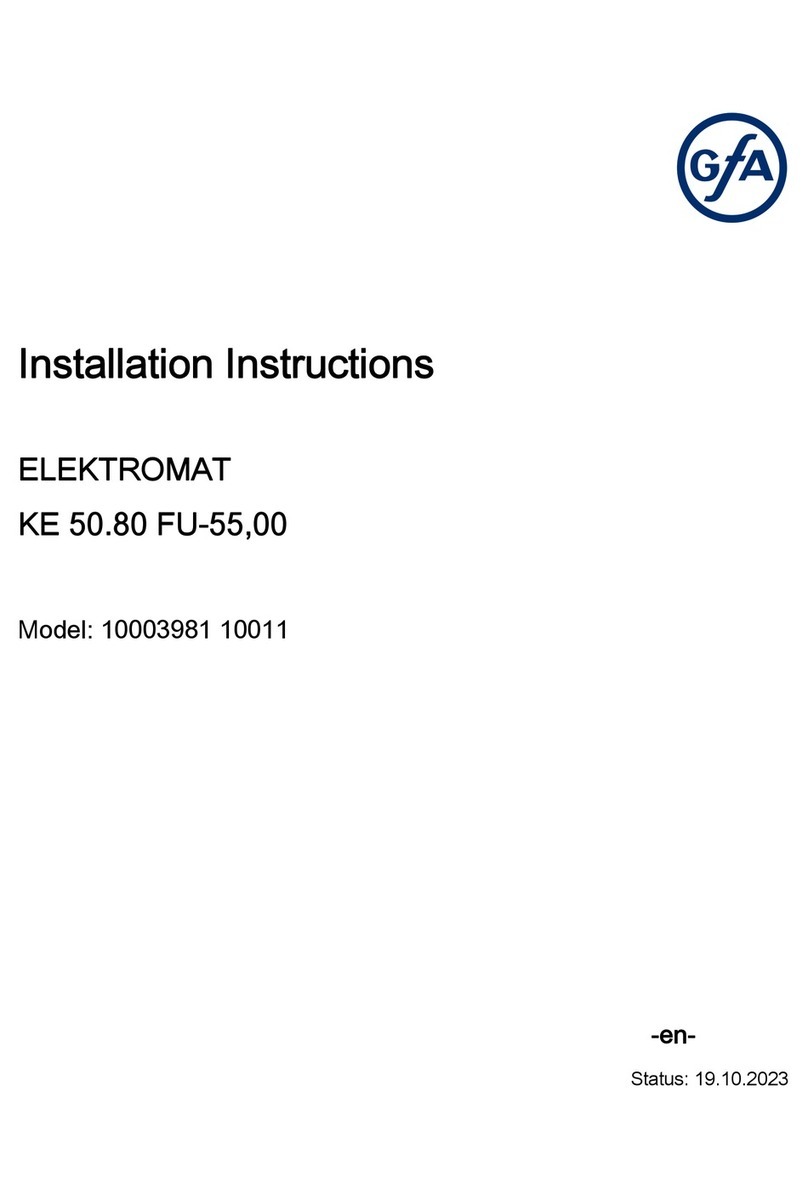
GFA
GFA 10003981 10011 installation instructions
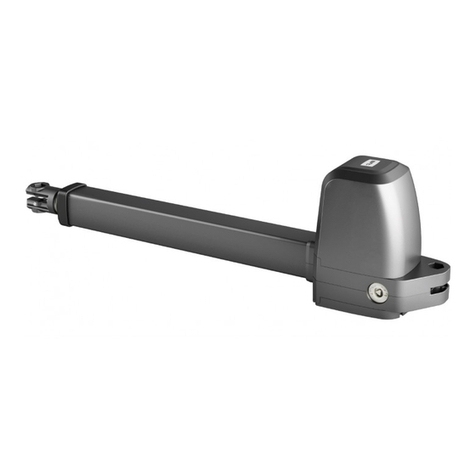
BFT
BFT ATHOS AC 25A installation manual
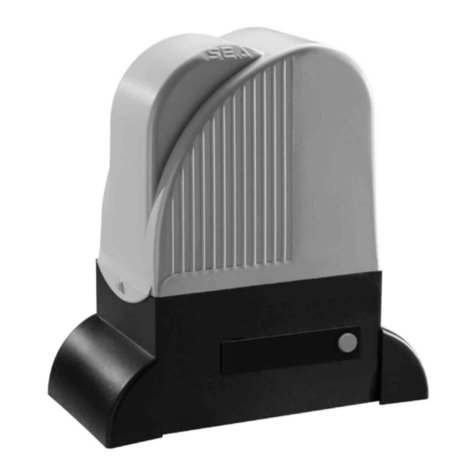
SEA
SEA LEPUS Series quick start guide
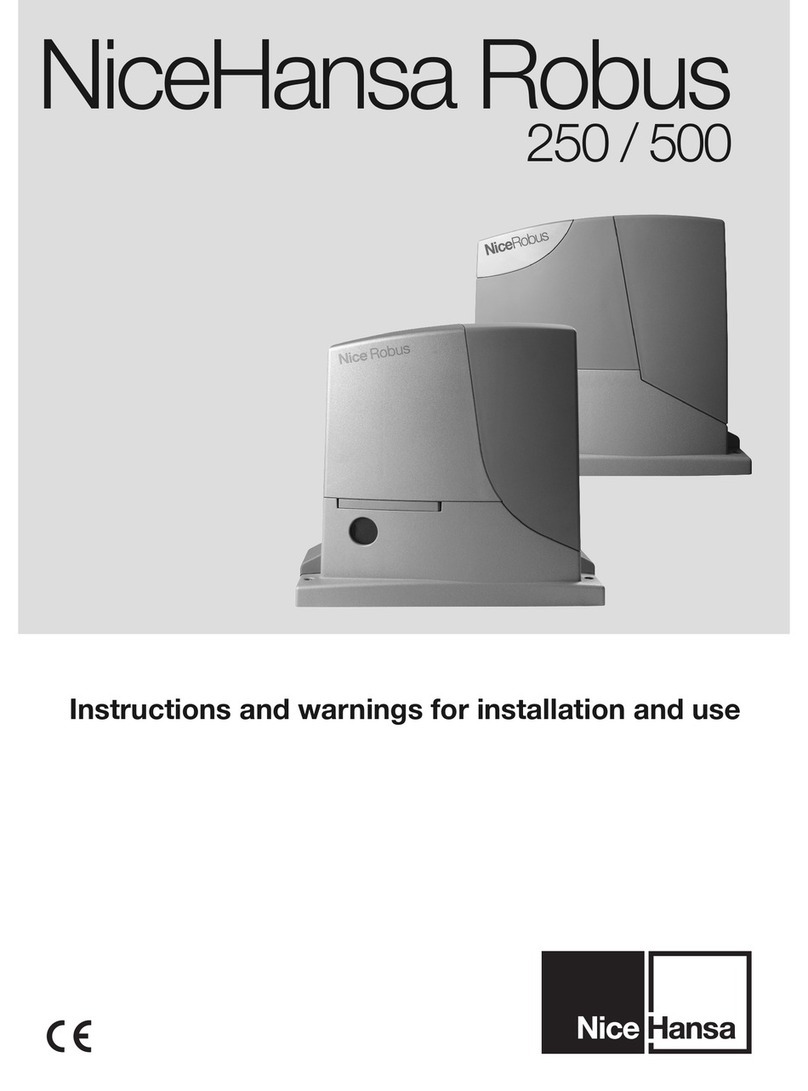
Nice Hansa
Nice Hansa Robus 250 Instructions and warnings for installation and use
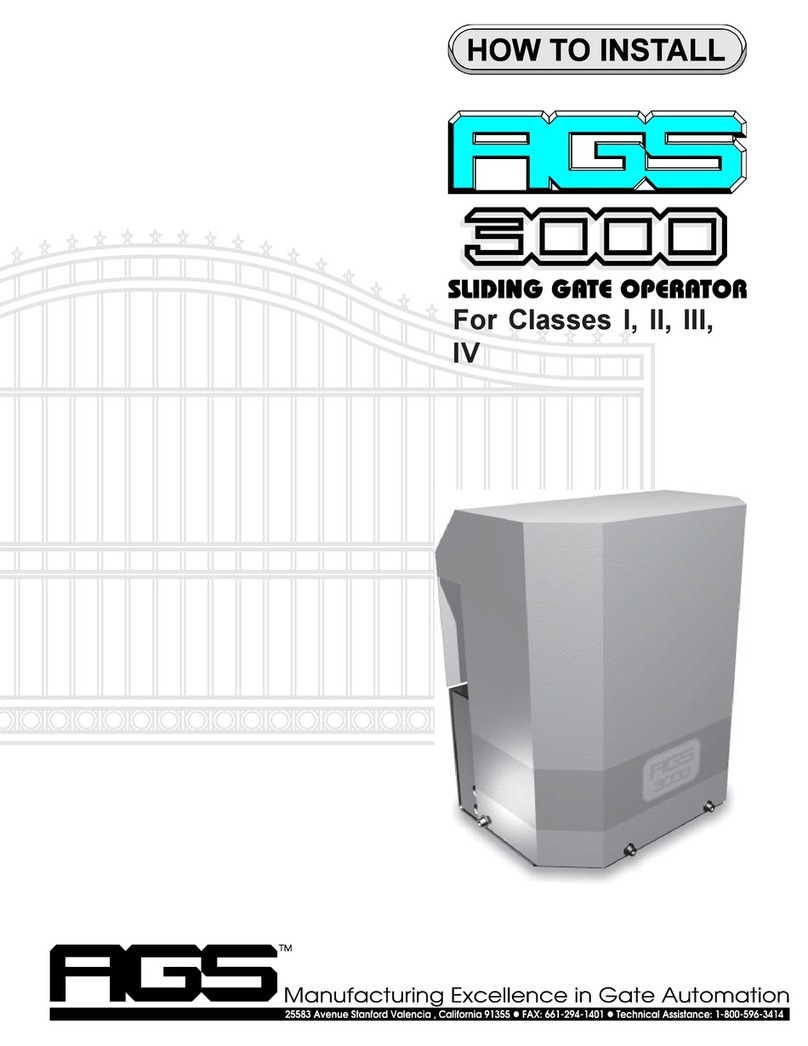
Chamberlain
Chamberlain 3000 installation instructions
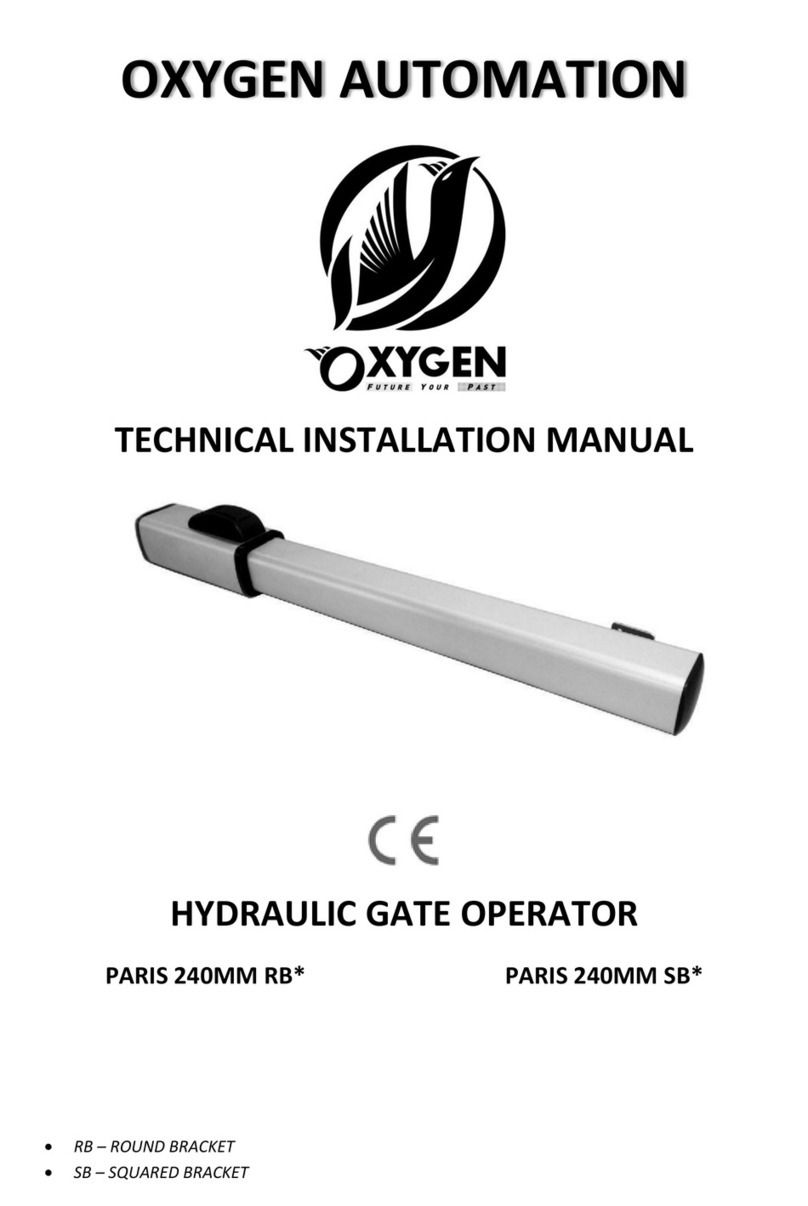
Oxygen
Oxygen PARIS 240MM RB Series Technical installation manual
